Search Result
Results for "
SH-SY5Y
" in MedChemExpress (MCE) Product Catalog:
3
Biochemical Assay Reagents
| Cat. No. |
Product Name |
Target |
Research Areas |
Chemical Structure |
-
- HY-P5902
-
-
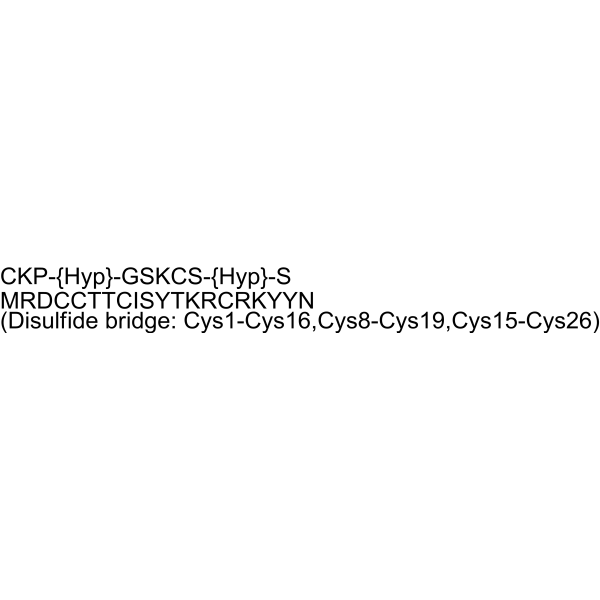
-
- HY-N12657
-
|
|
Others
|
Neurological Disease
|
|
Retinestatin, a new polyol polyketide, can protect SH-SY5Y dopaminergic cells from MPP + (HY-W008719)-induced cytotoxicity. Retinestatin shows neuroprotective effects in an in vitro model of Parkinson’s disease .
|
-
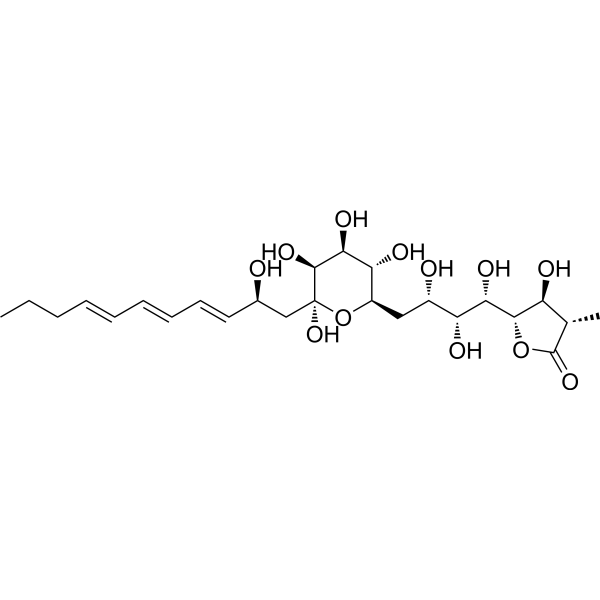
-
- HY-153166
-
|
|
GSK-3
|
Neurological Disease
|
|
PT-65 is a potent and selective GSK3 degrader with the highest degradation capacity of GSK3α (DC50= 28.3 nM) and GSK3β (DC50= 34.2 nM) in SH-SY5Y cells. PT-65 can be used in Alzheimer's disease research .
|
-

-
- HY-P3275
-
|
Aβ(17-40)
|
Amyloid-β
|
Neurological Disease
|
|
β-Amyloid (17-40) (Aβ(17-40)) is a fragment of Amyloid-β peptide that has shown neurotoxic activities in SH-SY5Y and IMR-32 cells. β-Amyloid (17-40) can be used for the research of neurological disease .
|
-

-
- HY-163189
-
|
|
Bcr-Abl
|
Neurological Disease
|
|
c-ABL-IN-6 (compound A6) is a c-ABL inhibitor with IC50 value of 16.6 nM. c-ABL-IN-6 displays higher neuroprotective effects against SH-SY5Y cell death induced by MPP + (HY-W008719). c-ABL-IN-6 can be used for the research of neurodegenerative disorder .
|
-
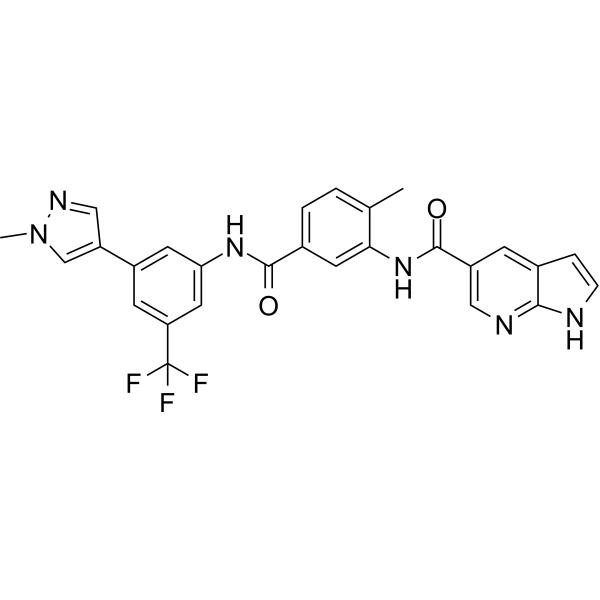
-
- HY-147938
-
|
|
Cholinesterase (ChE)
Amyloid-β
|
Neurological Disease
|
|
AChE-IN-19 (compound A15) is a highly potent AChE inhibitor with an IC50 value of 0.56 μM, also inhibits Aβ aggregation. AChE-IN-19 has potent neuroprotective activities and nearly no toxicity on SH-SY5Y cells. AChE-IN-19 can be used for researching Alzheimer's disease .
|
-
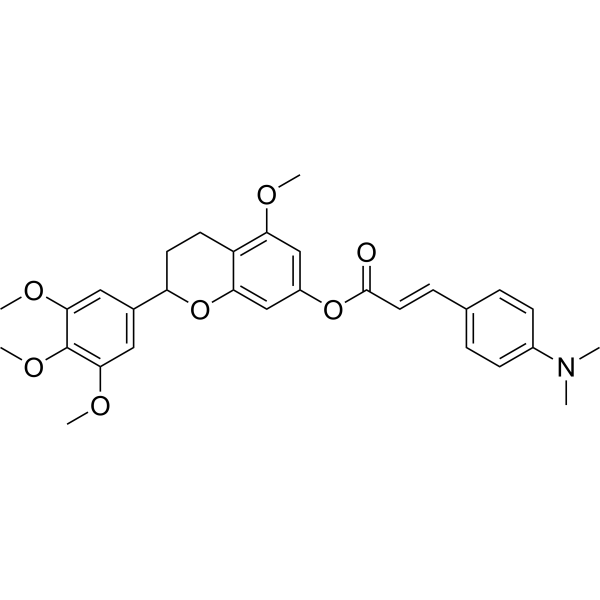
-
- HY-144826
-
|
|
GSK-3
|
Neurological Disease
|
|
ZDWX-25 is a highly potent GSK-3β and DYRK1A dual inhibitor with an IC50 value of 71 nM for GSK-3β. ZDWX-25 possesses significant cytotoxic activities against SH-SY5Y and HL-7702 cells. ZDWX-25 can be used for researching alzheimer's disease .
|
-
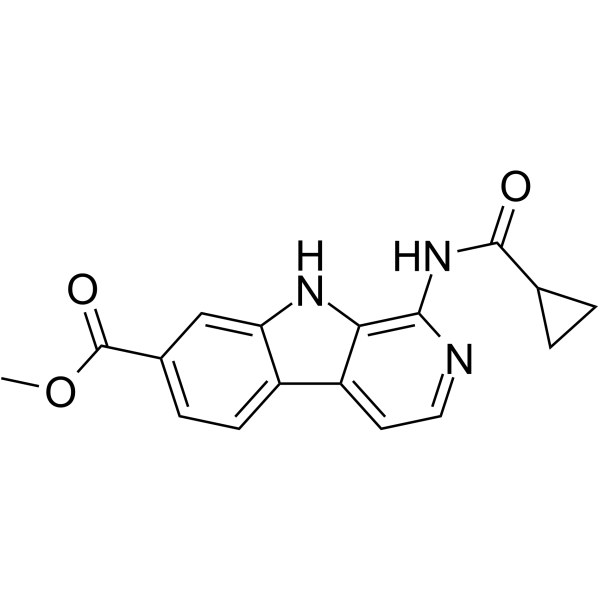
-
- HY-162340
-
|
|
Cholinesterase (ChE)
|
Neurological Disease
|
|
Z32439948 is a butyrylcholinesterase (BChE) inhibitor (IC50: 1.4 μM, hBChE) and is a derivative of m-sulfamoylbenzamide. Z32439948 also exhibited neuroprotective effects against glutamate in SH-SY5Y cells .
|
-

-
- HY-P5894
-
|
Galanin-like peptide (3-32)
|
Neuropeptide Y Receptor
|
Neurological Disease
|
|
human GALP (3-32) (Galanin-like peptide (3-32)) is a potent galanin receptor agonist with high affinity for both GalR1 (IC50=33 nM) and GalR2 (IC50=15 nM) in a competitive binding study. human GALP (3-32) exhibits the high potency in altering the extracellular acidification rate of SH-SY5Y cells transfected with GalR2 (EC50=360 nM) .
|
-

-
- HY-N0076
-
|
(-)-Bilobalide
|
Apoptosis
Autophagy
Endogenous Metabolite
|
Neurological Disease
|
|
Bilobalide, a sesquiterpene trilactone constituent of Ginkgo biloba, inhibits the NMDA-induced efflux of choline with an IC50 value of 2.3 µM. Bilobalide prevents apoptosis through activation of the PI3K/Akt pathway in SH-SY5Y cells. Exerts protective and trophic effects on neurons .
|
-

-
- HY-139708
-
|
|
iGluR
|
Neurological Disease
|
|
NMDA receptor antagonist-3, a NMDA receptor antagonist, stands out with a remarkable percentage of recovery (40.0%, at 100 μM) and safe toxicological profile in SH-SY5Y and human adipose mesenchymal stem cells.
|
-
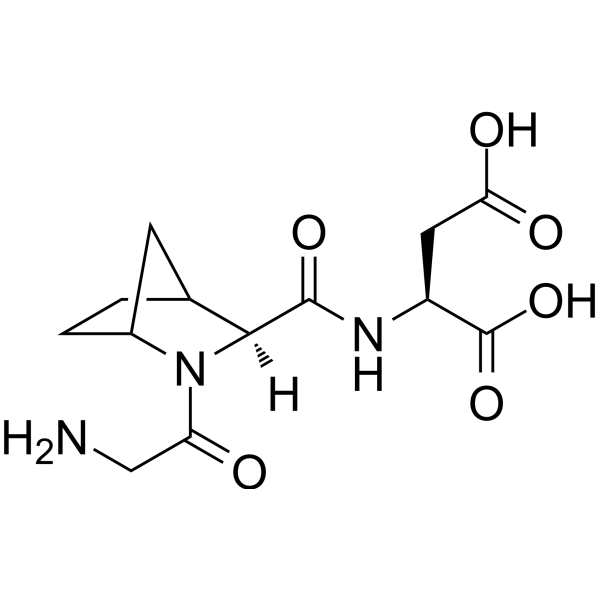
-
- HY-N5045
-
|
|
Others
|
Inflammation/Immunology
|
|
Jionoside A1 isolated from Radix Rehmanniae Praeparata displays dose dependent immune-enhancement activity and possesses moderate protective activities on H2O2-treated SH-SY5Y cells .
|
-
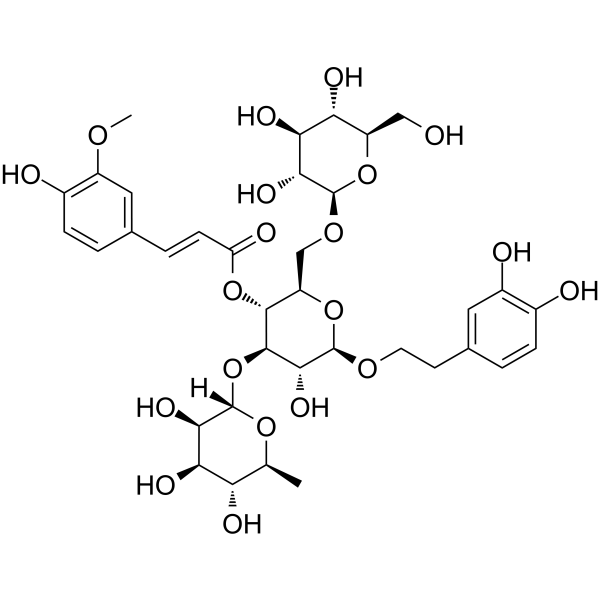
-
- HY-146140
-
|
|
Amyloid-β
|
Neurological Disease
|
|
Aβ-IN-4 (compound 12) is a potent amyloid β (Aβ) inhibitor. Aβ-IN-4 inhibits Aβ42 aggregation. However, Aβ-IN-4 can not alleviate the neurotoxicity of Aβ42 in SH-SY5Y cells. Aβ-IN-4 can not change the aggregation state of Aβ42 into a nontoxic one .
|
-
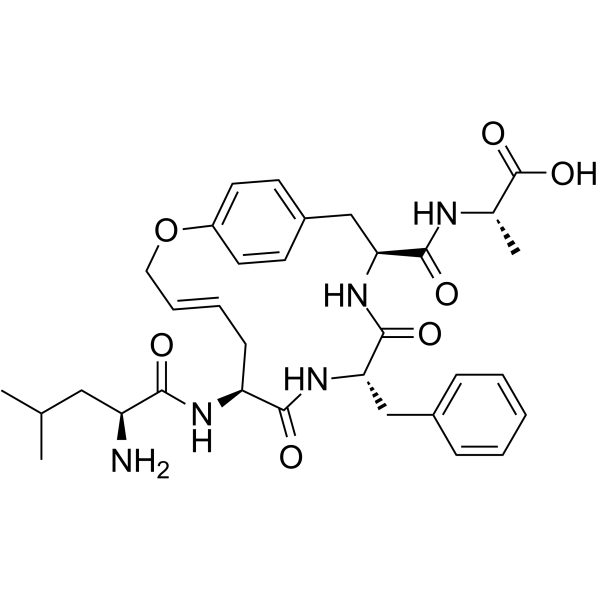
-
- HY-146139
-
|
|
Amyloid-β
|
Neurological Disease
|
|
Aβ-IN-3 (compound 1) is a potent amyloid β (Aβ) inhibitor. Aβ-IN-3 inhibits Aβ42 aggregation. However, Aβ-IN-3 can not alleviate the neurotoxicity of Aβ42 in SH-SY5Y cells. Aβ-IN-3 can not change the aggregation state of Aβ42 into a nontoxic one .
|
-
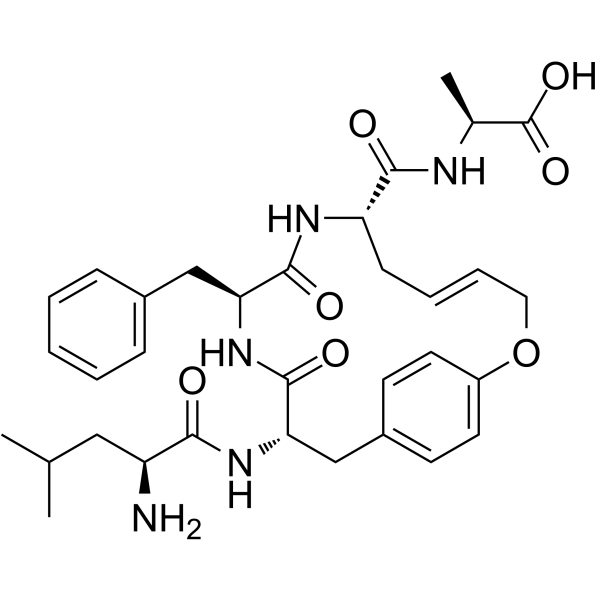
-
- HY-145243
-
|
|
Apoptosis
|
Others
|
|
PDPOB is a phenyl carboxylic acid derivative. PDPOB displays protective roles against OGD/R-evoked multiaspect neuronal deterioration in SH-SY5Y cells, as evidenced by alleviated mitochondrial dysfunction, oxidative stress, and apoptosis. PDPOB has the potential for the research of cerebral ischemia .
|
-
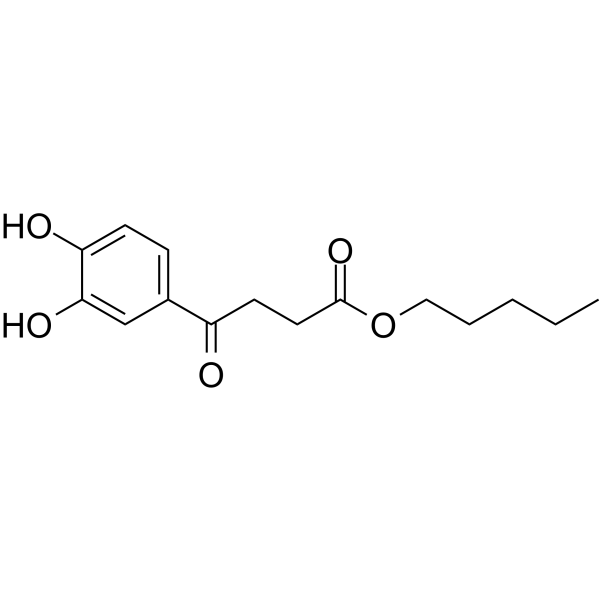
-
- HY-106224B
-
|
Hypocretin-1 (human, rat, mouse) (acetate)
|
Orexin Receptor (OX Receptor)
|
Neurological Disease
|
|
Orexin A (Hypocretin-1) (human, rat, mouse) acetate is a hypothalamic neuropeptide with analgesic properties (crosses the blood-brain barrier). Orexin A (human, rat, mouse) acetate is also an OX1R agonist that induces the expression of BDNF and TH proteins in SH-SY5Y cells in a time- and dose-dependent manner. Orexin A (human, rat, mouse) acetate can be used in studies of appetite regulation, neurodegenerative diseases and modulation of injurious messaging .
|
-
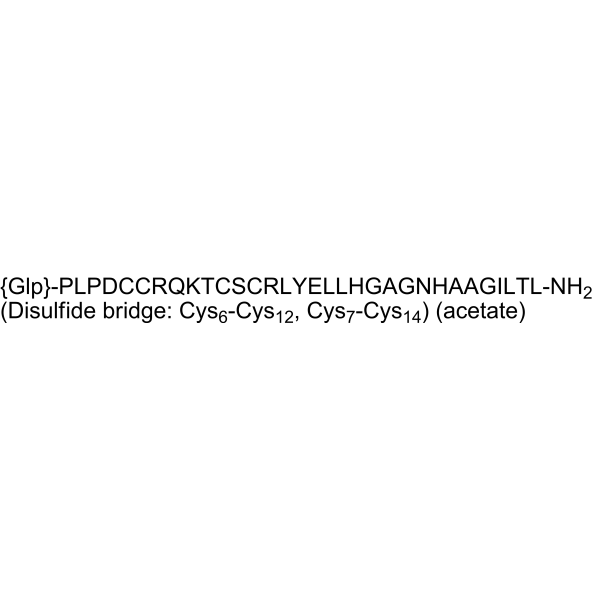
-
- HY-147939
-
|
|
Cholinesterase (ChE)
Amyloid-β
|
Cancer
|
|
AChE/BuChE-IN-3 is a potent and blood-brain barrier (BBB) penetrant AChE and BuChE dual inhibitor with IC50s of 0.65 μM and 5.77 μM for AChE and BuChE. AChE/BuChE-IN-3 also inhibits Aβ1-42 aggregation. AChE/BuChE-IN-3 has effectively neuroprotective activities and nearly no toxicity on SH-SY5Y cells. AChE/BuChE-IN-3 can be used for researching Alzheimer's disease .
|
-

-
- HY-161156
-
|
|
Cholinesterase (ChE)
|
Neurological Disease
Cancer
|
|
BChE-IN-26 (Compound 7b) is a selective AChE and BChE inhibitor with Ki value of 35 μM and 1.6 μM. BChE-IN-26 has cytotoxicity to human neuroblastoma (SH-SY5Y) cell line. BChE-IN-26 can be used for the research of Alzheimer’s disease .
|
-

-
- HY-N8161
-
|
Kaempferol 3,7-diglucoside
|
Glucosidase
Cholinesterase (ChE)
|
Neurological Disease
|
|
Kaempferol-3,7-di-O-β-glucoside (Kaempferol 3,7-diglucoside), a flavonol, possesses enzyme inhibition property towards α-amylase, α-glucosidase and Acetylcholinesterase. Kaempferol-3,7-di-O-β-glucoside protects differentiating neuronal cells, SH-SY5Y from Amyloid β peptide-induced injury. Kaempferol-3,7-di-O-β-glucoside has the potential for Alzheimer's research .
|
-
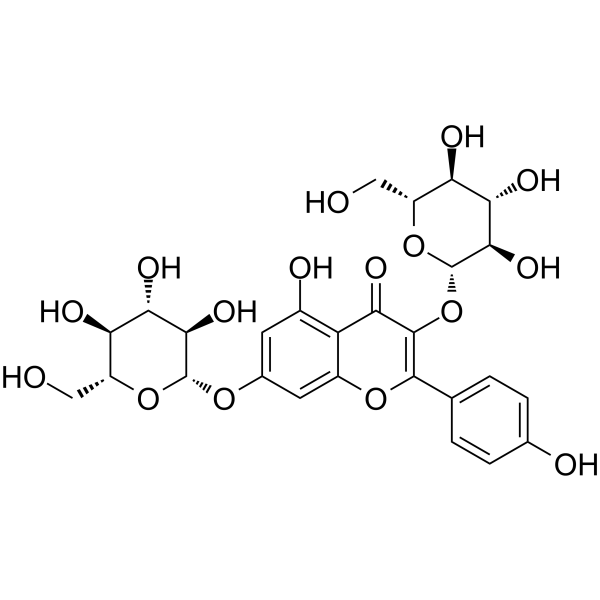
-
- HY-14374
-
GPP78
1 Publications Verification
CAY10618
|
NAMPT
Autophagy
|
Inflammation/Immunology
Cancer
|
|
GPP78 (CAY10618) is a potent Nampt inhibitor with an IC50 of 3.0 nM for nicotinamide adenine dinucleotide (NAD) depletion. GPP78 is cytotoxic to neuroblastoma cell line SH-SY5Y cells with an IC50 of 3.8 nM by inducing autophagy. GPP78 has anti-cancer and anti-inflammatory effects .
|
-
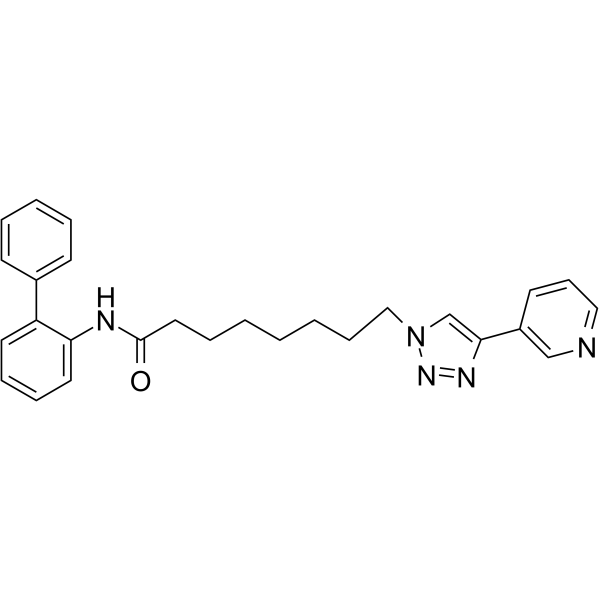
-
- HY-155466
-
|
|
Dopamine Receptor
|
Neurological Disease
|
|
Boc-MIF-1-Am (compound 2) is a human dopamine D2 receptor enhancer (EC50=17.82 nM) and is a bioconjugate of melanostatin (MIF-1) and amantadine. Boc-MIF-1-Am (200 μM) exhibited mild neurotoxicity in SH-SY5Y cells .
|
-
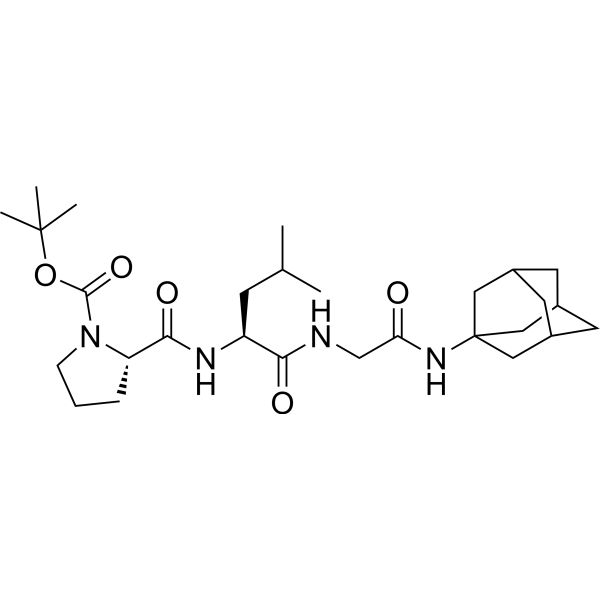
-
- HY-10974
-
|
|
γ-secretase
|
Neurological Disease
Cancer
|
|
MK-0752 is a potent, orally active and specific γ-secretase inhibitor, showing dose-dependent reduction of Aβ40 with an IC50 of 5 nM in human SH-SY5Y cells. MK-0752 crosses the blood-brain barrier. MK-0752 reduces newly generated CNS Aβ in vivo .
|
-
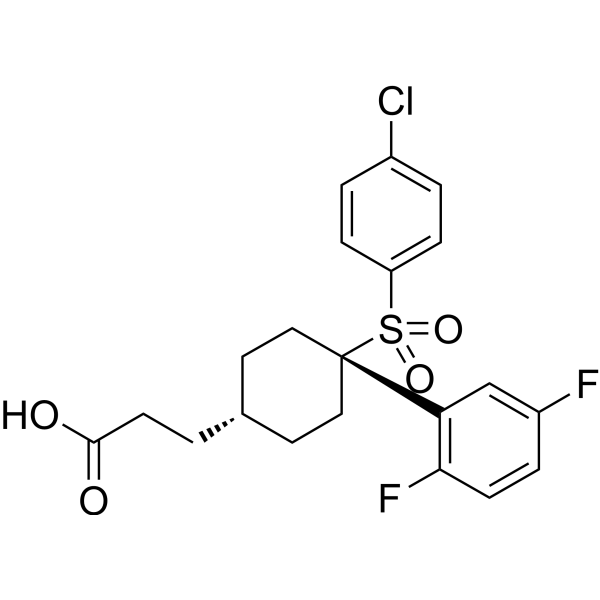
-
- HY-136182A
-
|
|
Na+/Ca2+ Exchanger
|
Cardiovascular Disease
Neurological Disease
|
|
YM-244769 is a potent, selective and orally active Na +/Ca 2+ exchanger (NCX) inhibitor. YM-244769 preferentially inhibits NCX3 and suppresses the unidirectional outward NCX current (Ca 2+ entry mode), with IC50s of 18 nM and 50 nM, respectively. YM-244769 efficiently protects against hypoxia/reoxygenation-induced SH-SY5Y neuronal cell damage. YM-244769 can also increase urine volume and urinary excretion of electrolytes in mice .
|
-

-
- HY-107659
-
|
|
Na+/Ca2+ Exchanger
|
Cardiovascular Disease
Neurological Disease
|
|
YM-244769 hydrochloride is a potent, selective and orally active Na +/Ca 2+ exchanger (NCX) inhibitor. YM-244769 hydrochloride preferentially inhibits NCX3 and suppresses the unidirectional outward NCX current (Ca 2+ entry mode), with IC50s of 18 nM and 50 nM, respectively. YM-244769 hydrochloride efficiently protects against hypoxia/reoxygenation-induced SH-SY5Y neuronal cell damage. YM-244769 hydrochloride can also increase urine volume and urinary excretion of electrolytes in mice .
|
-

-
- HY-136182
-
|
|
Na+/Ca2+ Exchanger
|
Cardiovascular Disease
Neurological Disease
|
|
YM-244769 dihydrochloride is a potent, selective and orally active Na +/Ca 2+ exchanger (NCX) inhibitor. YM-244769 dihydrochloride preferentially inhibits NCX3 and suppresses the unidirectional outward NCX current (Ca 2+ entry mode), with IC50s of 18 nM and 50 nM, respectively. YM-244769 dihydrochloride efficiently protects against hypoxia/reoxygenation-induced SH-SY5Y neuronal cell damage. YM-244769 dihydrochloride can also increase urine volume and urinary excretion of electrolytes in mice .
|
-

-
- HY-146483
-
|
|
Amyloid-β
|
Neurological Disease
Inflammation/Immunology
|
|
Anti-Aβ agent 1A (compound M15) has potent activity against amyloid-β. Anti-Aβ agent 1A possesses can significantly inhibit LPS-induced levels of IL-1β, IL-6 and TNF-α, and reduces the apoptosis of SH-SY5Y induced by H2O2 through mitochondria pathway. Anti-Aβ agent 1A possesses antioxidant, anti-inflammatory, anti-Aβ toxicity and neuroprotective activities. Anti-Aβ agent 1A can be used for researching Alzheimer’s disease (AD) .
|
-

-
- HY-134205A
-
|
|
Keap1-Nrf2
|
Neurological Disease
Metabolic Disease
|
|
CBR-470-1 is an inhibitor of the glycolytic enzyme phosphoglycerate kinase 1 (PGK1). CBR-470-1 is also a non-covalent Nrf2 activator. CBR-470-1 protects SH-SY5Y neuronal cells against MPP +-induced cytotoxicity through activation of the Keap1-Nrf2 cascade .
|
-

-
- HY-N1970
-
|
|
|
|
|
5,7-Dihydroxychromone, the extract of Cudrania tricuspidata, activates Nrf2/ARE signal and exerts neuroprotective effects against 6-hydroxydopamine (6-OHDA)-induced oxidative stress and apoptosis. 5,7-Dihydroxychromone inhibits the expression of activated caspase-3 and caspase-9 and cleaved PARP in 6-OHDA-induced SH-SY5Y cells .
|
-
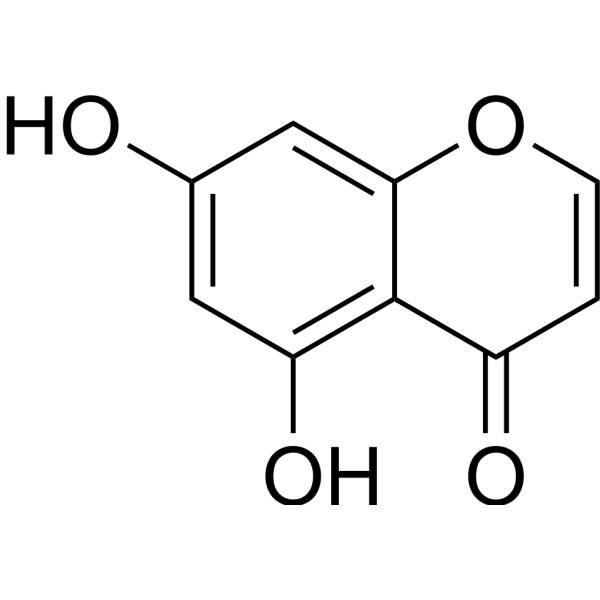
-
- HY-112371
-
|
|
CDK
|
Cancer
|
|
(S)-CR8 is the S-isomer of CR8. (S)-CR8 is a potent and selective CDK inhibitor with IC50s of 0.060, 0.080, 0.11, 0.12, and 0.15 μM for CDK2/cyclin E, CDK2/cyclin A, CDK9/cyclin T, CDK5/p25, and CDK1/cyclin B, respectively. (S)-CR8 reduces SH-SY5Y cells survival (IC50 0.40 μM) .
|
-
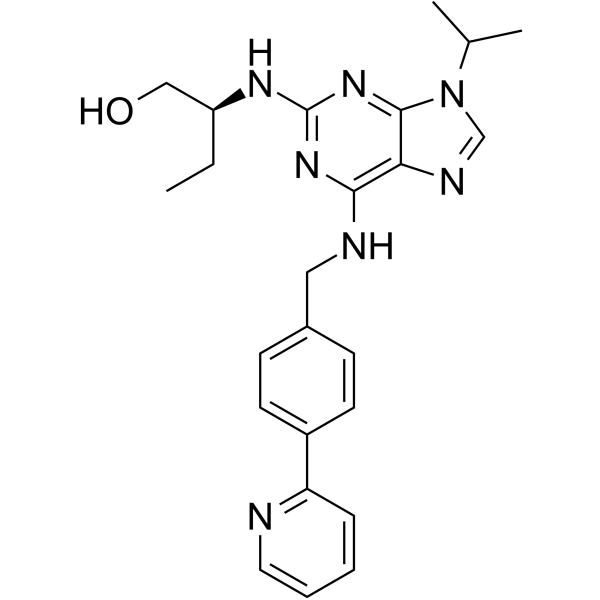
-
- HY-156348
-
|
|
Monoamine Oxidase
Autophagy
Apoptosis
Cholinesterase (ChE)
|
Neurological Disease
|
|
MAO-B-IN-26 (Compound IC9) is a MAO-B and acetylcholinesterase inhibitor. MAO-B-IN-26 protects SH?SY5Y cells against Aβ induced cytotoxicity, morphological changes, ROS generation and membrane damage. MAO-B-IN-26 also inhibits Aβ induced autophagy and apoptosis. MAO-B-IN-26 can be used as a neuroprotective agent against Alzheimer’s disease .
|
-

-
- HY-146691
-
|
|
Monoamine Oxidase
|
Neurological Disease
|
|
hMAO-B-IN-2 (compound 6j) is an orally active, potent, selective and BBB penetrated and competitive reversible hMAO-B inhibitor, with an IC50 of 4 nM. hMAO-B-IN-2 shows low toxicity and good neuroprotective effects in SH-SY5Y cell. hMAO-B-IN-2 can be used for alzheimer’s disease research . hMAO-B-IN-2 is a click chemistry reagent, itcontains an Alkyne group and can undergo copper-catalyzed azide-alkyne cycloaddition (CuAAc) with molecules containing Azide groups.
|
-

-
- HY-N10764
-
|
|
Others
|
Cancer
|
|
Acetylexidonin is a diterpenoid compound with anti-inflammation and cancer activity. Acetylexidonin inhibits tumor cells with IC50s of 3.69 μM (NB4) and 26.22 μM (SHSY5Y), respectively .
|
-
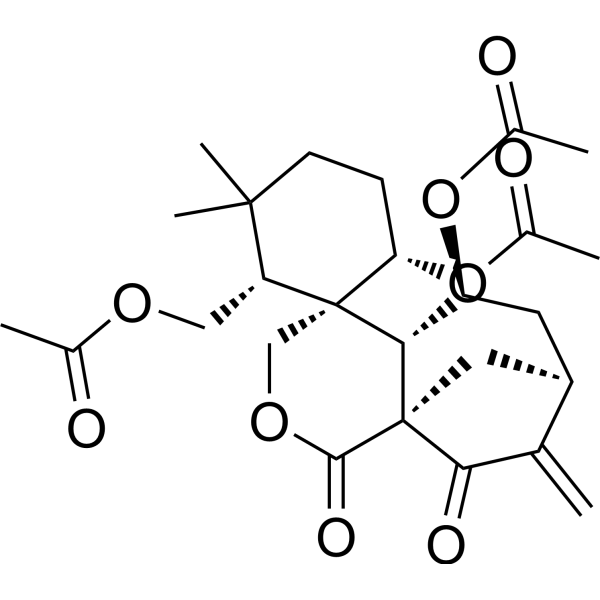
-
- HY-N0303
-
|
|
Mitochondrial Metabolism
Apoptosis
|
Neurological Disease
|
|
Idebenone, a well-appreciated mitochondrial protectant, exhibits protective efficacy against neurotoxicity and can be used for the research of Alzheimer's disease, Huntington's disease. Idebenone (oxidised form) has a dose-dependent inhibitory effect on the enzymatic metabolism of arachidonic acid in astroglial homogenates (IC50=16.65 μM) . Idebenone, a coenzyme Q10 analog and an antioxidant, induces apoptotic cell death in the human dopaminergic neuroblastoma SHSY-5Y cells . Idebenone quickly crosses the blood-brain barrier.
|
-

-
- HY-117482
-
|
|
γ-secretase
|
Neurological Disease
|
|
BPN-15606 is a highly potent, orally active γ-secretase modulator (GSM), attenuates the production of Aβ42 and Aβ40 by SHSY5Y neuroblastoma cells with IC50 values of 7 nM and 17nM, respectively. BPN-15606 lowers Aβ42 and Aβ40 levels in the central nervous system of rats and mice. BPN-15606 has acceptable PK/PD properties, including bioavailability, half-life, and clearance .
|
-
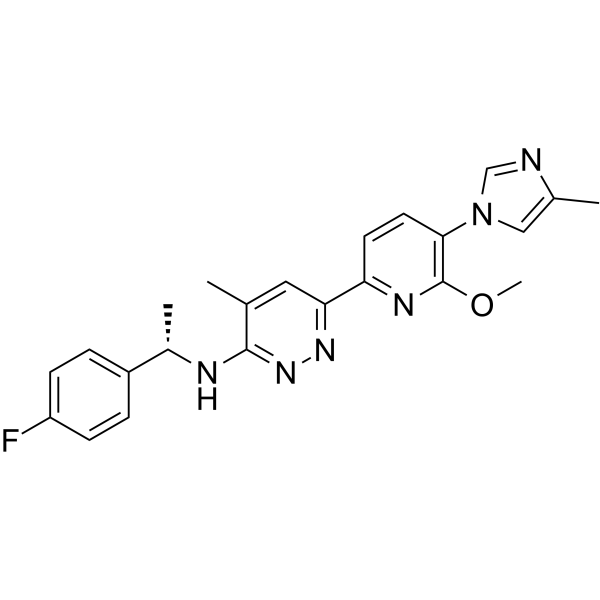
-
- HY-117482A
-
|
|
γ-secretase
|
Neurological Disease
|
|
BPN-15606 besylate is a highly potent, orally active γ-secretase modulator (GSM), attenuates the production of Aβ42 and Aβ40 by SHSY5Y neuroblastoma cells with IC50 values of 7 nM and 17nM, respectively. BPN-15606 besylate lowers Aβ42 and Aβ40 levels in the central nervous system of rats and mice. BPN-15606 besylate has acceptable PK/PD properties, including bioavailability, half-life, and clearance .
|
-
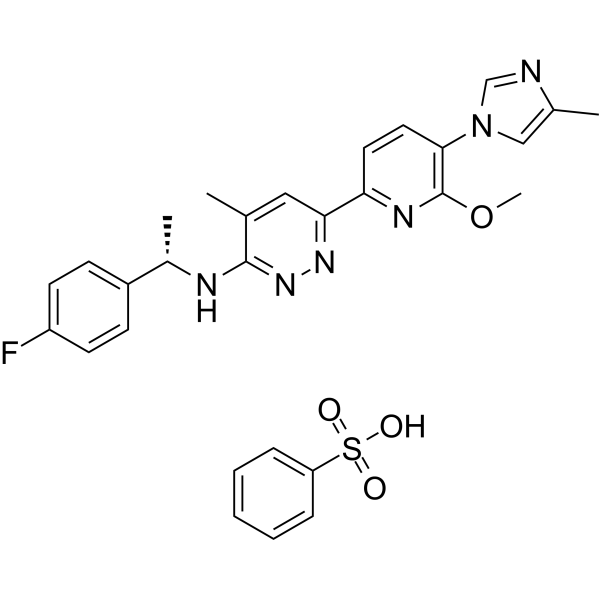
-
- HY-N8931
-
|
Lithospermic acid monomethyl ester
|
Akt
|
Neurological Disease
|
|
Monomethyl lithospermate activates the PI3K/AKT pathway, which plays a protective role in nerve injury. Monomethyl lithospermate can improve the survival ability of SHSY-5Y cells, inhibit the breakdown of mitochondrial membrane potential (MMOP) and inhibit cell apoptosis. Monomethyl lithospermate also reduced the level of oxidative stress in the brain tissue of rats with middle artery occlusion (MCAO) and improved nerve damage in rats with ischemic stroke (IS) .
|
-

-
- HY-163441
-
|
|
Cholinesterase (ChE)
|
Neurological Disease
|
|
BChE-IN-31 (Compound 14d) is a selective BChE inhibitor with an IC50 of 65 nM. BChE-IN-31 inhibits the self-induced aggregation of neurotoxic amyloid-β (Aβ) peptide .
|
-

-
- HY-152232
-
|
|
Cholinesterase (ChE)
|
Cancer
|
|
BChE-IN-15 (Compound 6) is a pseudo-irreversible and covalent BChE inhibitor with an IC50 of 1.76 nM against hBChE .
|
-

-
- HY-P5839
-
|
|
nAChR
|
Neurological Disease
|
|
α-Conotoxin MrIC is an α7nAChR biased agonist. α-Conotoxin MrIC exclusively activates α7nAChR regulated by type II positive allosteric modulators, including PNU120596. α-Conotoxin MrIC can be used to study neurological diseases and also to probe the pharmacological properties of α7nAChR .
|
-
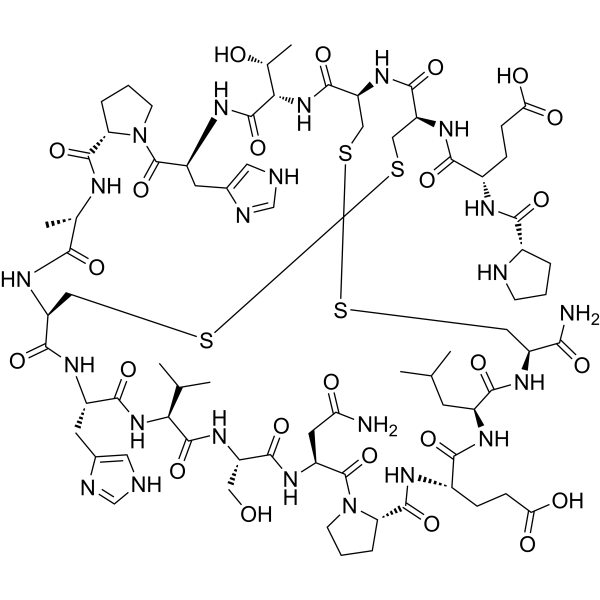
-
- HY-138669
-
|
|
PROTACs
Tau Protein
|
Neurological Disease
|
|
C004019 is a small-molecule PROTAC. C004019 simultaneously recruites tau and E3-ligase (Vhl) and thus selectively enhances ubiquitination and proteolysis of tau proteins. C004019 can be used for Alzheimer disease (AD) research .
|
-

-
- HY-W012875
-
|
β-Nitropropionic acid; Bovinocidin
|
Bacterial
Apoptosis
Autophagy
|
Infection
Metabolic Disease
|
|
3-Nitropropanoic acid (β-Nitropropionic acid) is an irreversible and orally active inhibitor of succinate dehydrogenase. 3-Nitropropanoic acid exhibits potent antimycobacterial activity with a MIC value of 3.3 μM. 3-Nitropropanoic acid can induce cell apoptosis .
|
-
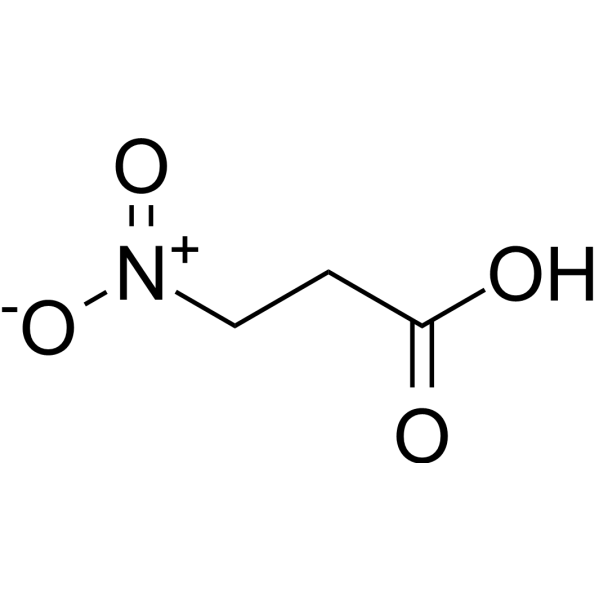
-
- HY-N10431
-
|
|
Keap1-Nrf2
|
Neurological Disease
|
|
Stigmane B (Compound 2) is a nuclear factor E2-related factor (Nrf2) activator. Stigmane B downregulates apoptosis and reactive oxygen species (ROS) generation, and increases antioxidant enzyme activities. Stigmane B shows neuroprotective effects .
|
-
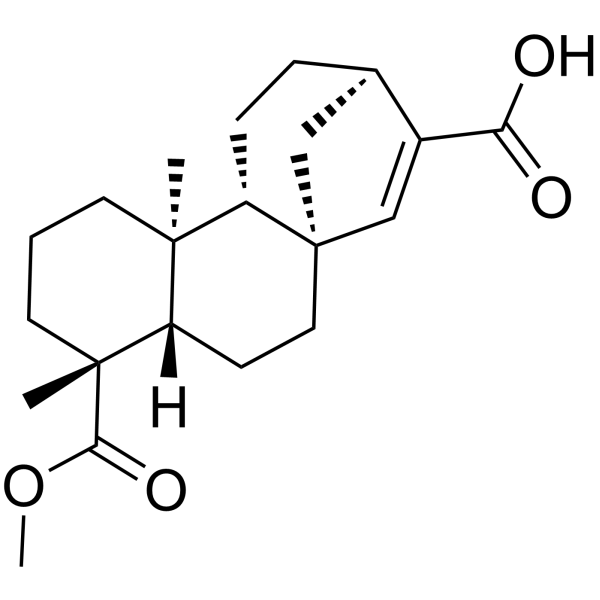
-
- HY-N0639
-
|
|
HBV
Pyroptosis
Carbonic Anhydrase
|
Infection
Inflammation/Immunology
|
|
Punicalin is a species that can be isolated from the leaves of Punica granatum. Punicalin is an active molecule against hepatitis b virus (HBV). Punicalin can induce pyroptosis. Punicalin is a Carbonic anhydrase inhibitor. Punicalin blocks the binding of S-glycoprotein and ACE2 receptors. Pnuicalin has anti-inflammatory, antioxidant and antiviral activity [5] .
|
-
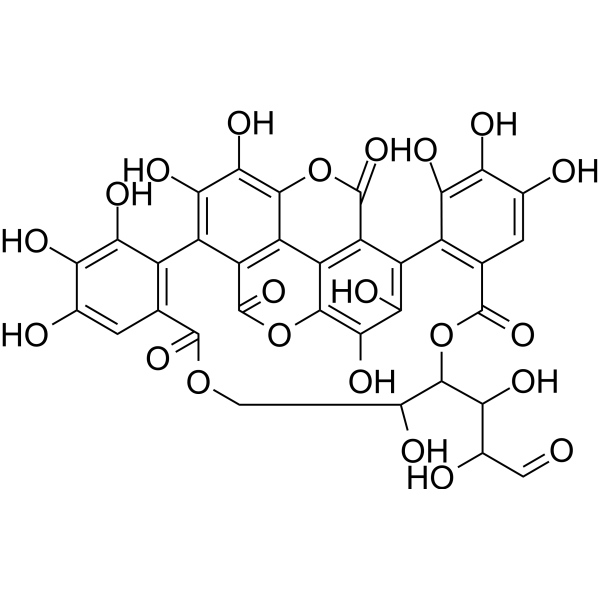
-
- HY-146037
-
|
|
Apoptosis
Aurora Kinase
|
Cancer
|
|
Aurora A inhibitor 2 (Compound 16h) is a potent Aurora A kinase inhibitor with an IC50 of 21.94 nM. Aurora A inhibitor 2 induces caspase-dependent apoptosis in MDA-MB-231 cells .
|
-
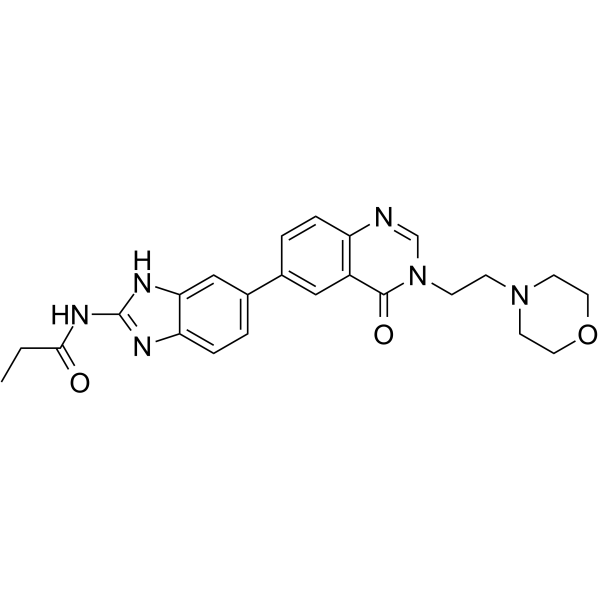
-
- HY-149233
-
-

-
- HY-149845
-
|
|
GSK-3
PROTACs
|
Neurological Disease
|
|
PROTAC GSK-3β Degrader-1 (compound 1) is a degrader targets GSK-3β degradation with an IC50 value of 833 nM. PROTAC GSK-3β Degrader-1 contains SB-216763 (a GSK-3β inhibitor), a PEG linker and a CRBN (E3 ligase liand). PROTAC GSK-3β Degrader-1 reduces the neurotoxicity induced by Aβ25-35 peptide and CuSO4. PROTAC GSK-3β Degrader-1 can be used to research in Alzheimer's disease .
|
-
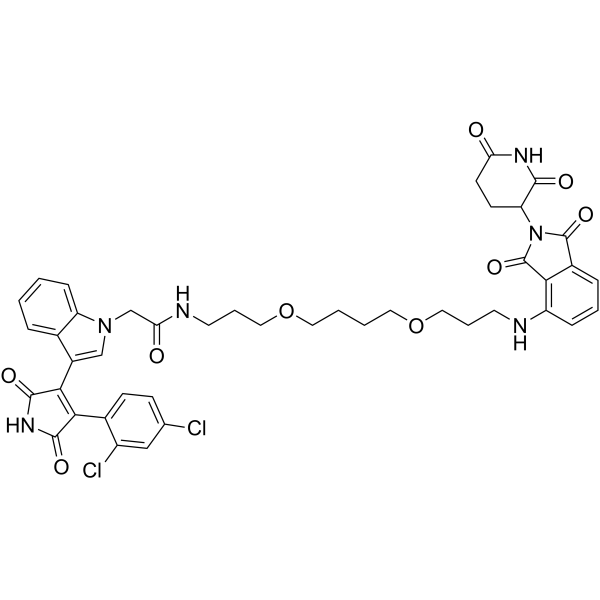
-
- HY-149477
-
|
|
Monoamine Oxidase
|
Neurological Disease
|
|
IHC3 is a competitive and reversible MAO-B inhibitor (IC50: 1.672 μM). IHC3 can interact with the amino acid Cys172 of MAO-B. IHC3 can be used for neurological diseases research .
|
-
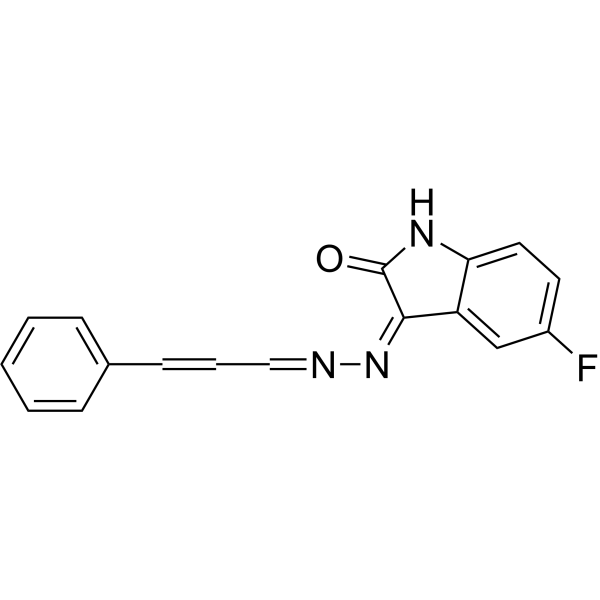
-
- HY-162338
-
|
|
Cholinesterase (ChE)
|
Neurological Disease
|
|
BChE-IN-29 (Compound 27a) is a BChE inhibitor (IC50: 0.078 μM and 0.74 μM for BChE and AChE respectively). BChE-IN-29 has anti-inflammatory activity and can be used for research of AD .
|
-

-
- HY-163380
-
|
|
Carbonic Anhydrase
|
Neurological Disease
|
|
CA/MAO-B-IN-1 (Compound 78) is a dual inhibitor for human brain carbonic anhydrases (CA) and Monoamine Oxidase-B (MAO-B), with IC50s of 8.8 and 7.0 nM, respectively. CA/MAO-B-IN-1 reveals a human oral absorption of 71.9% through in silico prediction .
|
-
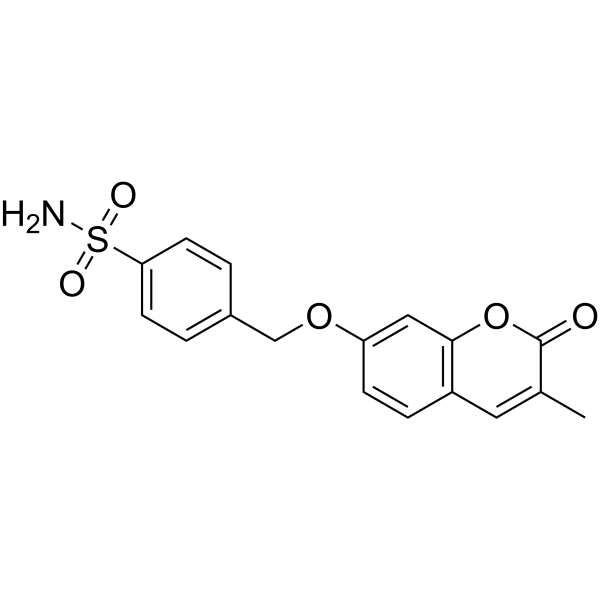
-
- HY-13505
-
-
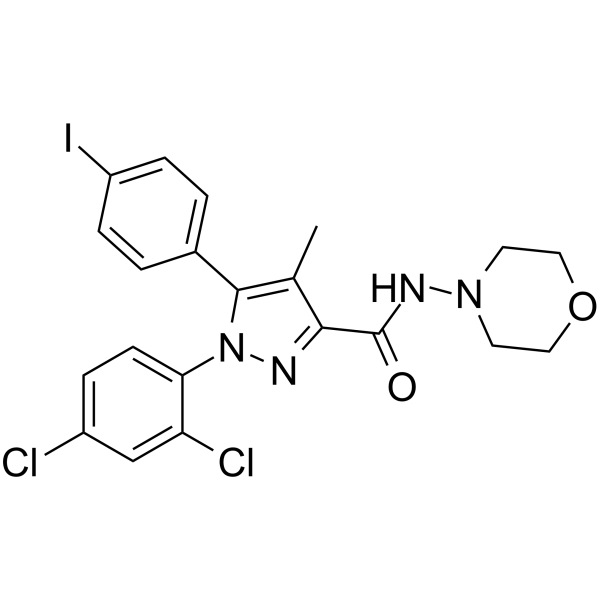
- HY-134476
-
|
|
NF-κB
|
Inflammation/Immunology
|
|
NF-κΒ activator 1 is a potent NF-κΒ activator with an EC50 of 0.9 μM. NF-κΒ activator 1 induces superoxide dismutase (SOD)2 mRNA expression .
|
-
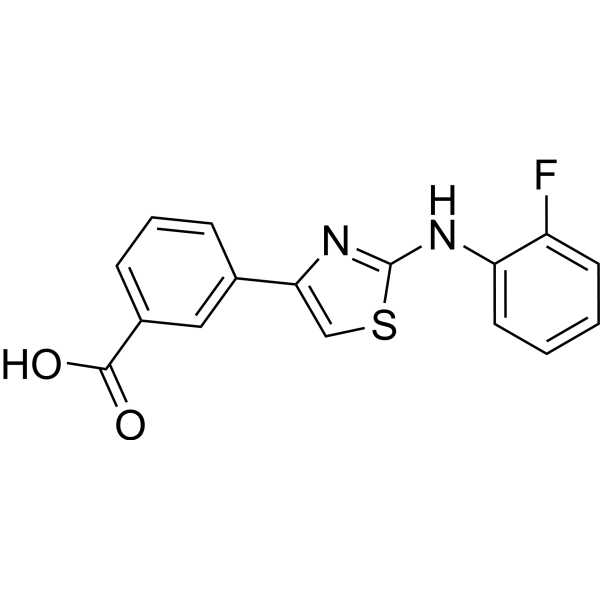
- HY-D1684
-
|
|
Amyloid-β
|
Neurological Disease
|
|
DCDAPH (Compound 2c) is a novel smart NIRF probe for detection of β-amyloid (Aβ) plaques (λex/λem=597/665 nm in PBS). DCDAPH shows high affinity for Aβ aggregates (Ki=37 nM, Kd=27 nM). DCDAPH shows good blood brain barrier permeation and can meet most of the requirements for the detection of Aβ plaques both in vitro and in vivo .
|
-
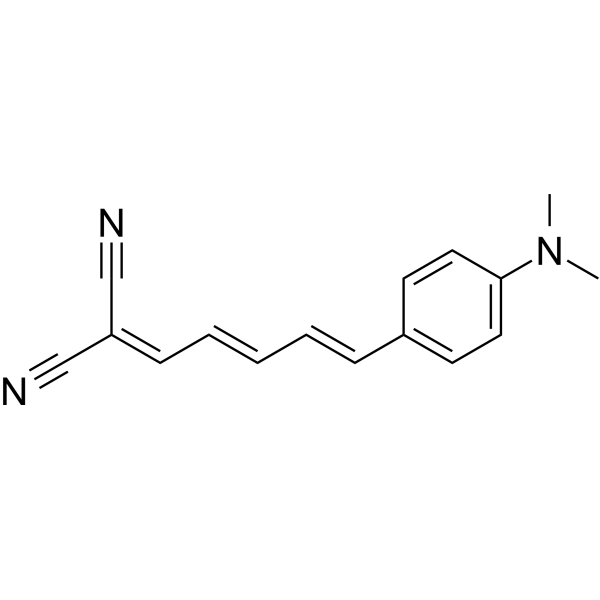
- HY-151405
-
|
|
Cholinesterase (ChE)
|
Neurological Disease
|
|
Z164597606 is a selective BChE inhibitor (IC50: 1.3 and 1.7 μM for eqBChE and hBChE). Z164597606 forms a π-π stacking interaction with the amino acid Trp82 of hBChE. Z164597606 can be used for the research of Alzheimer’s disease (AD) .
|
-
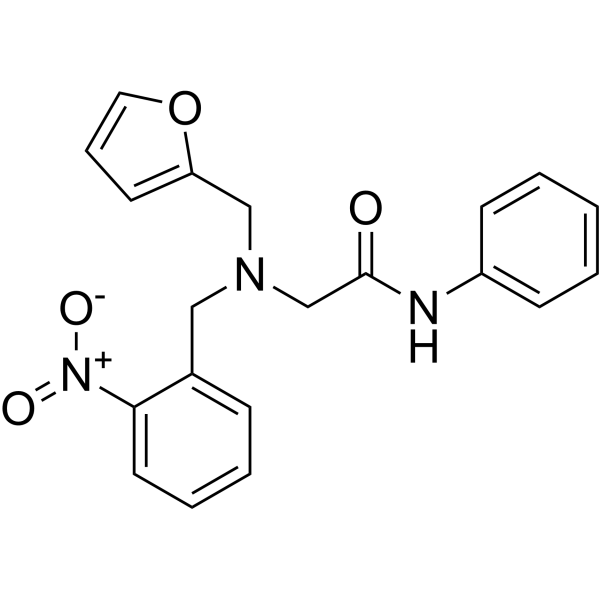
- HY-P3087
-
-
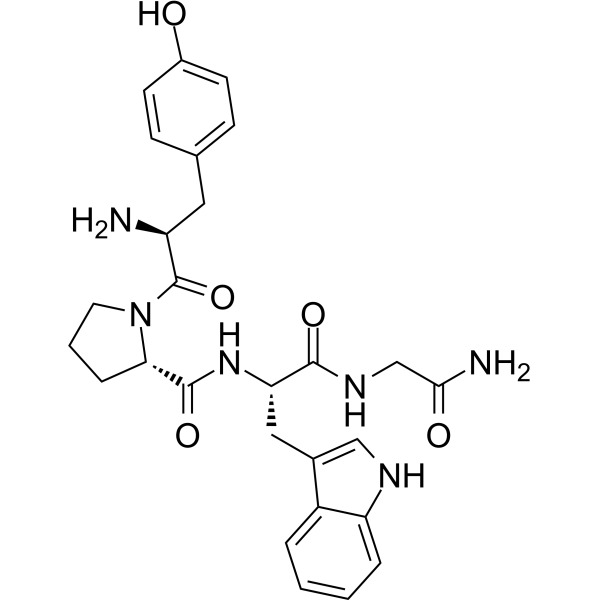
- HY-149212
-
|
|
Cholinesterase (ChE)
|
Neurological Disease
|
|
SD-6 is an orally active inhibitor of hAChE and hBChE with IC50 values of 0.907 µM and 1.579 µM, respectively. SD-6 has excellent blood-brain barrier (BBB) permeability and no neurotoxicity, which can be used for research on Alzheimer's disease .
|
-
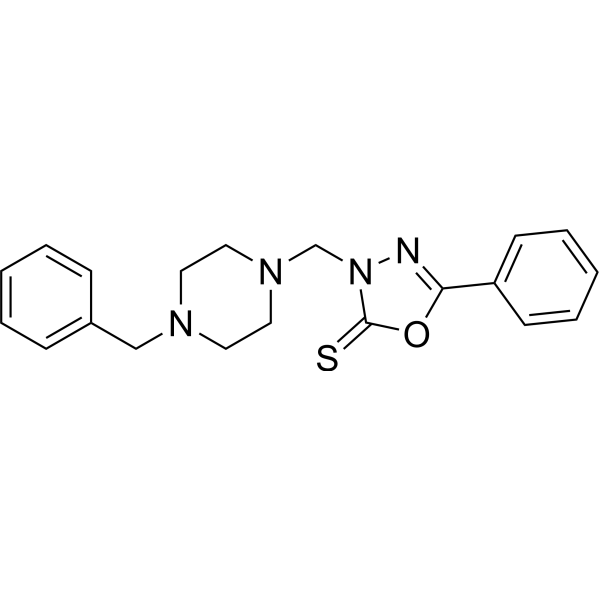
- HY-155085
-
|
|
Monoamine Oxidase
Amyloid-β
Cholinesterase (ChE)
|
Neurological Disease
|
|
hAChE-IN-3 (compounds 5c) is a potent and blood-brain barrier permeable AChE, BuChE, MAO-B-IN-1 and BACE-1 inhibitor, with IC50 values of 0.44, 0.08, 5.15 and 0.38 μM, respectively. hAChE-IN-3 has antioxidant activity and metal chelating ability. In addition, hAChE-IN-3 can bind to peripheral anion sites, and affect β amyloid and reduce Alzheimer's-associated neurodegeneration. hAChE-IN-3 has the potential for the research of Alzheimer's disease .
|
-
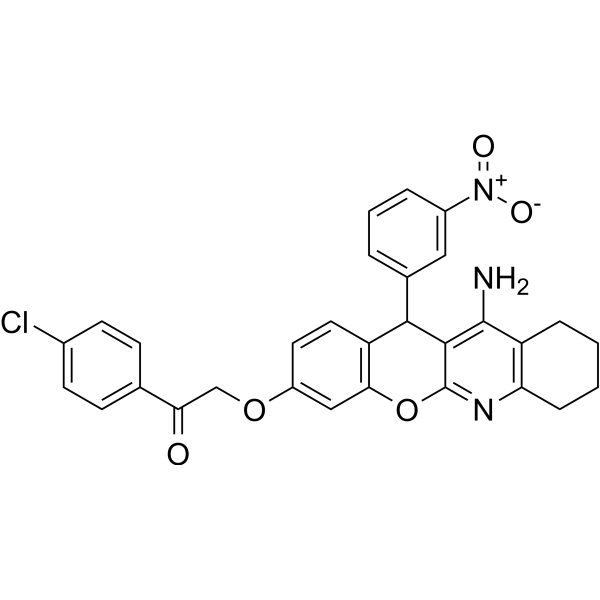
- HY-123230
-
|
CGA 279202
|
Fungal
Caspase
PARP
Apoptosis
|
Infection
Neurological Disease
|
|
Trifloxystrobin (CGA 279202) is a type of fungicide. Trifloxystrobin has toxicity, antiparasitic activity and induce apoptosis, oxidative stress and DNA damage. Trifloxystrobin can be used for the reaesrch of fungal diseases [5].
|
-

- HY-N2590
-
|
|
Parasite
PI3K
Akt
mTOR
NF-κB
|
Infection
Inflammation/Immunology
Cancer
|
|
Lupenone is an orally active lupine-type triterpenoid that can be isolated from Musa basjoo. Lupenone Lupenone plays a role through the PI3K/Akt/mTOR and NF-κB signaling pathways. Lupenone has anti-inflammatory, antiviral, antidiabetic and anticancer activities .
|
-
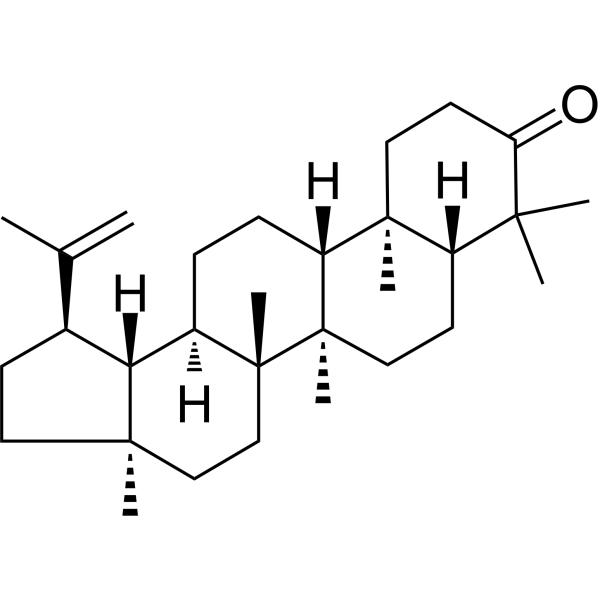
- HY-N8418
-
-
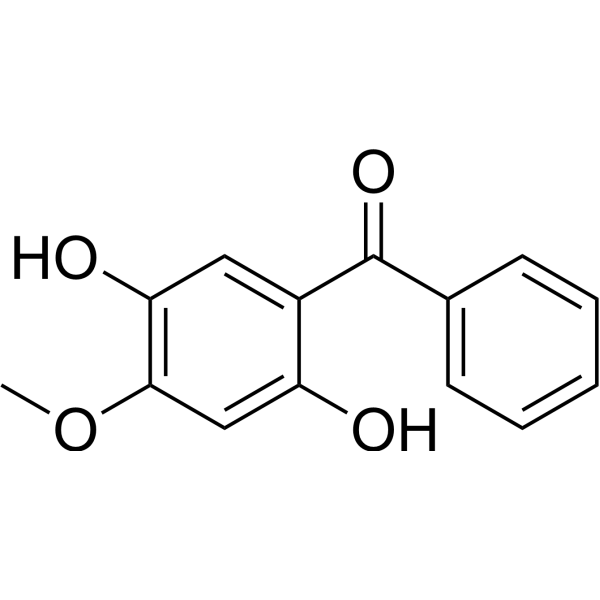
- HY-144695
-
|
|
DYRK
|
Neurological Disease
|
|
Dyrk1A/α-synuclein-IN-1 (Compound b1) is a dual Dyrk1A and α-synuclein aggregation inhibitor with IC50 values of 177 nM and 10.5 µM, respectively. Dyrk1A/α-synuclein-IN-1 has high predictive CNS penetration and neuroprotective effect .
|
-
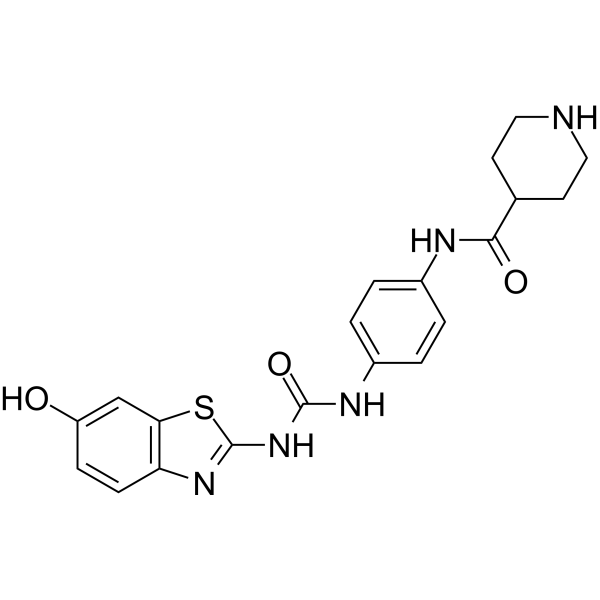
- HY-147980
-
|
|
Amyloid-β
Cholinesterase (ChE)
|
Neurological Disease
|
|
Aβ-IN-5 (Compound e12) is an orally active Aβ aggregation inhibitor. Aβ-IN-5 also inhibits AChE and BuChE with IC50 values of 21.29 μM and 1.32 μM, respectively. Aβ-IN-5 shows excellent neuroprotective effects and low neurotoxicity .
|
-
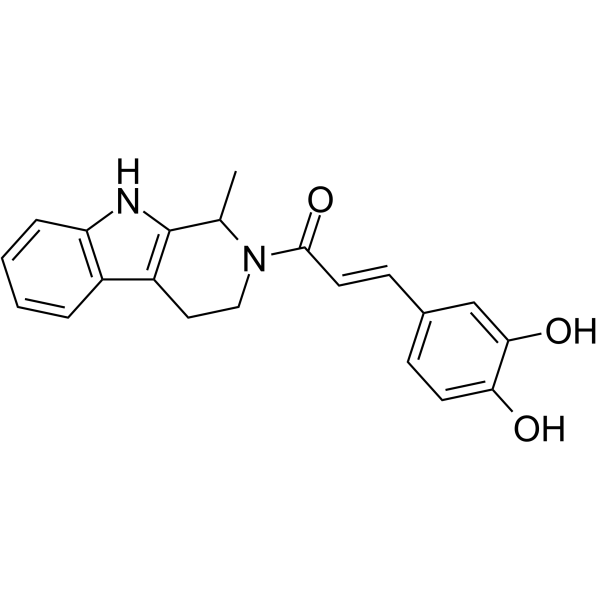
- HY-151615
-
|
|
Fluorescent Dye
|
Neurological Disease
|
|
DCI-Br-3 is a rapid, highly sensitive, and selective probe to monitor thiols in the epileptic brain. (λex=537 nm, λem=675 nm).DCI-Br-3 can effectively cross the blood-brain barrier (BBB) .
|
-

- HY-149272
-
-

- HY-157440
-
|
|
Amyloid-β
Reactive Oxygen Species
Cholinesterase (ChE)
|
Neurological Disease
|
|
AChE/Aβ-IN-3 (compound AM5) is a dual inhibitor of AChE and Amyloid-β aggregation with IC50<.sub> values of 1.29 and 4.93 μM, respectively. AChE/Aβ-IN-3 has antioxidant properties that scavenge ROS and restore their normal levels. AChE/Aβ-IN-3 can be used in the study of neurological diseases, such as Alzheimer's disease .
|
-

- HY-161240
-
|
|
Monoamine Oxidase
|
Neurological Disease
Inflammation/Immunology
|
|
MAO-B-IN-30 (compound IS7) is a potent, selective and cross the blood-brain barrier MAO-B inhibitor with IC50 values of 19.176, 0.082 µM for MAO-A and MAO-B, respectively. MAO-B-IN-30 shows antiproliferative activity and non-cytotoxic. MAO-B-IN-30 reduces TNF-alpha, IL-6, NF-kB levels. MAO-B-IN-30 has the potential for the research of Parkinson's disease .
|
-
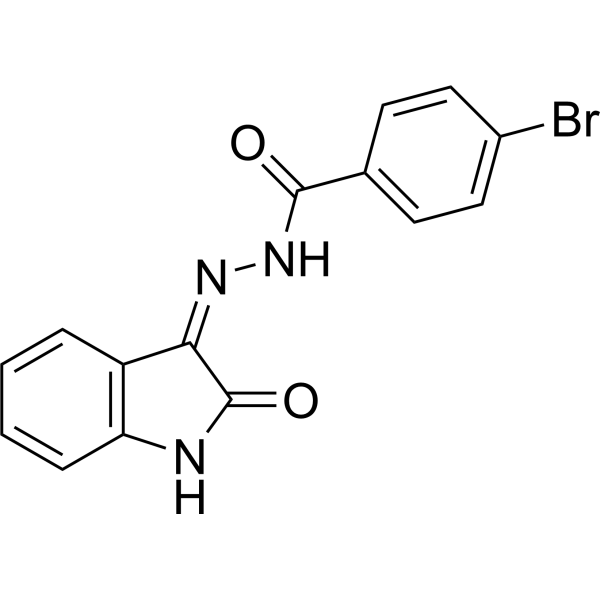
- HY-13237
-
-
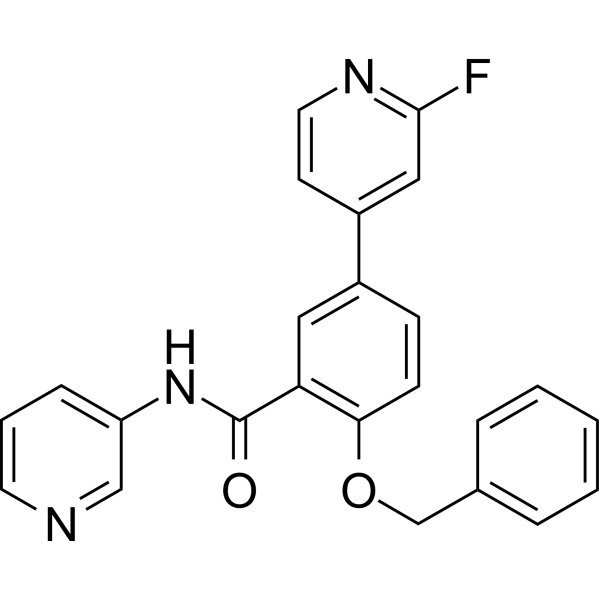
- HY-16009
-
-
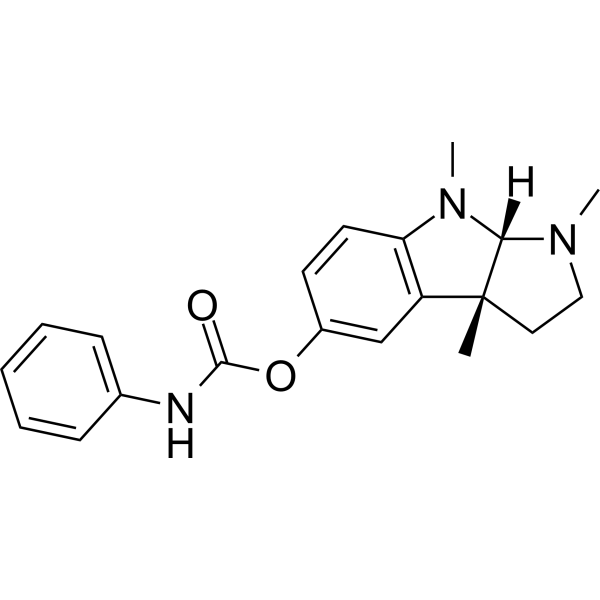
- HY-151596
-
-

- HY-15141G
-
|
Antibiotic AM-2282; STS; AM-2282
|
PKC
|
Infection
Cancer
|
|
Staurosporine (AM-2282) (GMP) is Staurosporine (HY-15141) produced by using GMP guidelines. GMP small molecules works appropriately as an auxiliary reagent for cell therapy manufacture. Staurosporine is a potent, ATP-competitive and non-selective inhibitor of protein kinases [5].
|
-
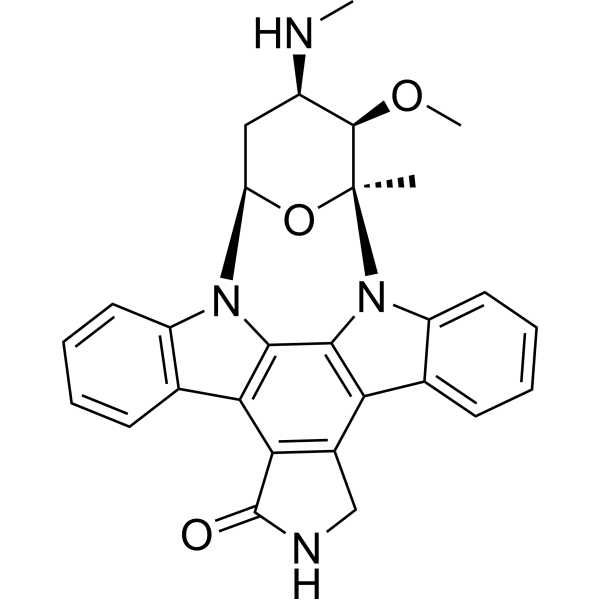
- HY-149967
-
|
|
iGluR
|
Neurological Disease
Inflammation/Immunology
|
|
GluN2B-NMDAR antagonist-1 is an orally active GluN2B-NMDAR antagonist. GluN2B-NMDAR antagonist-1 has neuroprotective activity. GluN2B-NMDAR antagonist-1 can be used for research of ischemic injury .
|
-
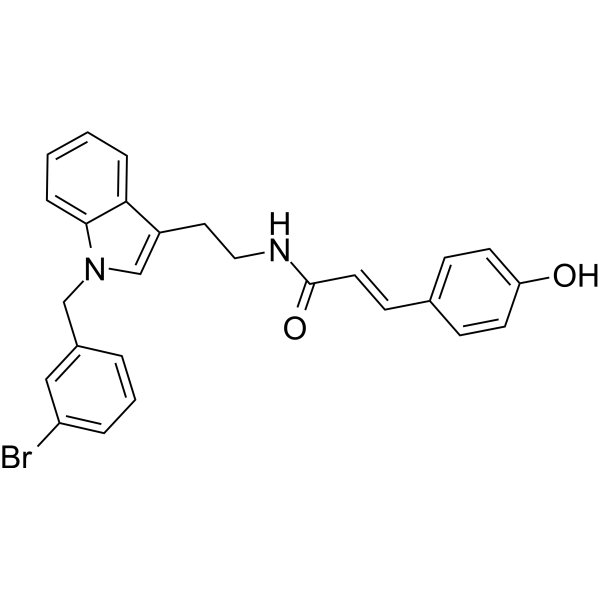
- HY-155022
-
|
|
Cholinesterase (ChE)
|
Neurological Disease
|
|
AChE-IN-30 is an AChE inhibitor with an IC50 value of 4.4 μM. AChE-IN-30 has neuroprotective activity, and inhibits H2O2-induced apoptosis by suppressing intracellular ROS accumulation. AChE-IN-30 can be used for research of Alzheimer's disease .
|
-
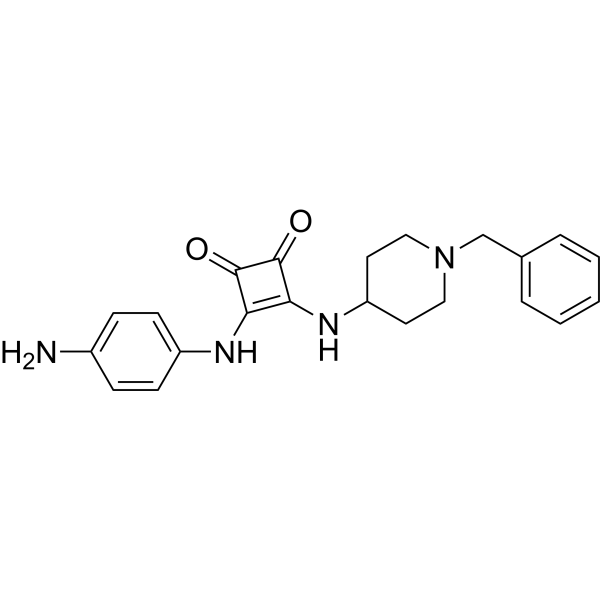
- HY-P5896
-
-

- HY-158131
-
|
|
FKBP
HSP
|
Neurological Disease
Cancer
|
|
FKBP51-Hsp90-IN-2 (Compound E08) is a selective FKBP51-Hsp90 protein-protein interaction inhibitor with IC50 values of 0.4 µM and 5 µM for FKBP51 and FKBP52, respectively. FKBP51-Hsp90-IN-2 also effectively stimulates cellular energy metabolism and neurite growth. FKBP51-Hsp90-IN-2 can be used in research on neurodegenerative diseases and cancer .
|
-
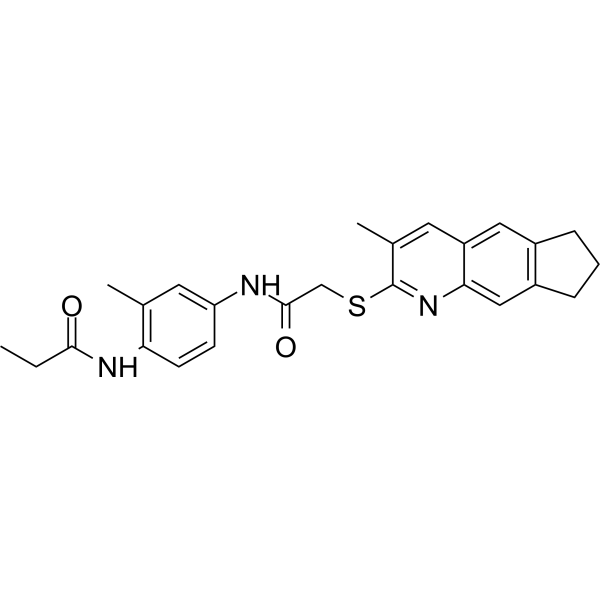
- HY-14608A
-
|
|
iGluR
Apoptosis
Ferroptosis
Endogenous Metabolite
|
Neurological Disease
|
|
L-Glutamic acid monosodium salt is an excitatory amino acid neurotransmitter that acts as an agonist for all subtypes of glutamate receptors (metabolic rhodophylline, NMDA, and AMPA). L-Glutamic acid monosodium salt has an agonist effect on the release of DA from dopaminergic nerve endings. L-Glutamic acid monosodium salt can be used in the study of neurological diseases [5].
|
-
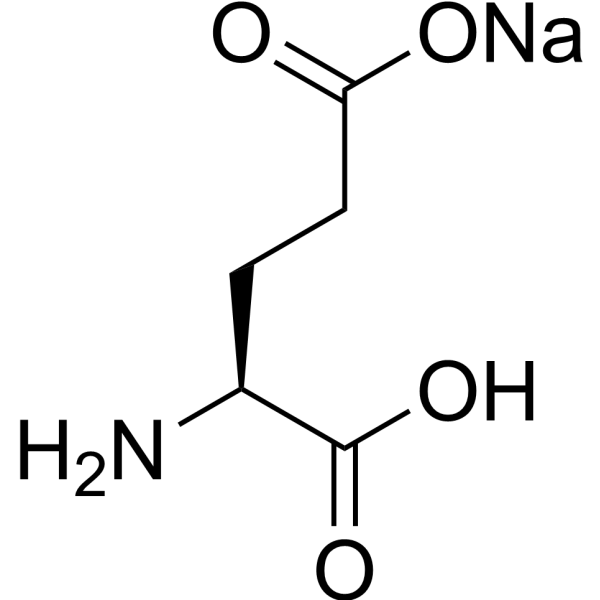
- HY-14608
-
|
|
Endogenous Metabolite
iGluR
Ferroptosis
Apoptosis
|
Neurological Disease
|
|
L-Glutamic acid is an excitatory amino acid neurotransmitter that acts as an agonist for all subtypes of glutamate receptors (metabolic rhodophylline, NMDA, and AMPA). L-Glutamic acid has an agonist effect on the release of DA from dopaminergic nerve endings. L-Glutamic acid can be used in the study of neurological diseases [5].
|
-
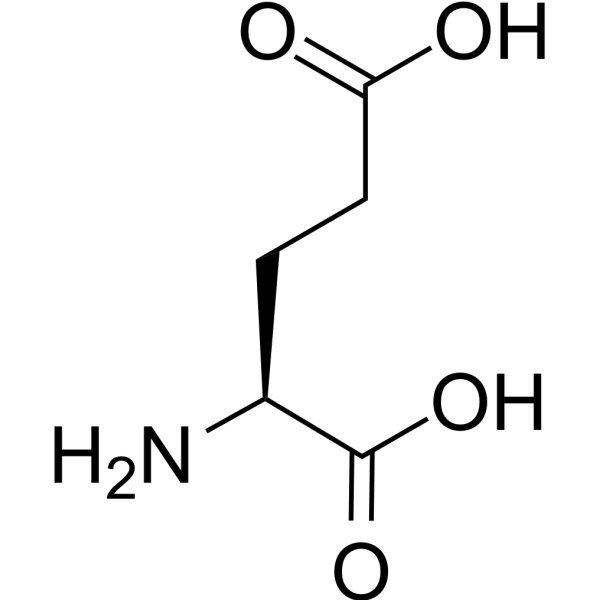
- HY-N0373
-
|
|
Amyloid-β
Apoptosis
NOD-like Receptor (NLR)
|
Neurological Disease
|
|
Licochalcone B is an extract from the root of Glycyrrhiza uralensis. Licochalcone B inhibits amyloid β (42) self-aggregation (IC50=2.16 μM) and disaggregate pre-formed Aβ42 fibrils, reduce metal-induced Aβ42 aggregation through chelating metal ionsLicochalcone B inhibits phosphorylation of NF-κB p65 in LPS signaling pathway. Licochalcone B inhibits growth and induces apoptosis of NSCLC cells. Licochalcone B specifically inhibits the NLRP3 inflammasome by disrupting NEK7‐NLRP3 interaction .
|
-

- HY-121027
-
|
(-)-Anagyrine; Monolupine; Rhombinine
|
mAChR
nAChR
|
Neurological Disease
|
|
Anagyrine ((-)-Anagyrine) is a quinolizidine alkaloid that has been found in Lupinus albus. Anagyrine binds to muscarinic and nicotinic acetylcholine receptors with IC50 values of 132 and 2096 µM respectively. Anagyrine is a potent and effective desensitizer of nAChR, and Anagyrine can directly, without metabolism, desensitize nAChR .
|
-

- HY-146389
-
|
|
MDM-2/p53
P-glycoprotein
|
Cancer
|
|
Anticancer agent 50 (compound 6) is a potent ABCB1 efflux pump modulator. Anticancer agent 50 shows cytotoxic effects and antiproliferative effects. Anticancer agent 50 decreases the expression of cyclin D1 and induces p53 expression. Anticancer agent 50 has the potential for the research of T-lymphoma .
|
-

- HY-151208
-
|
|
Monoamine Oxidase
|
Neurological Disease
|
|
MAO-B-IN-16 is a selective monoamine oxidase B (MAO-B) inhibitor, with an IC50 of 1.55 µM. MAO-B-IN-16 can be used in the study of central nervous disorders, such as parkinson's disease .
|
-
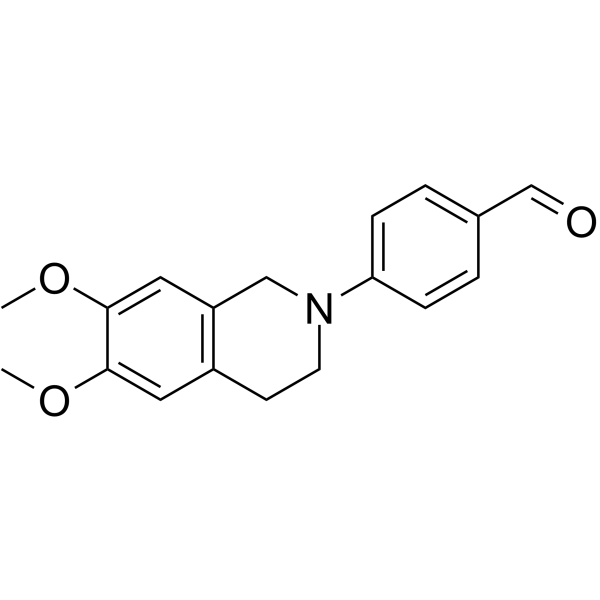
- HY-121027A
-
|
(-)-Anagyrine hydrochloride; Monolupine hydrochloride; Rhombinine hydrochloride
|
mAChR
nAChR
|
Neurological Disease
|
|
Anagyrine ((-)-Anagyrine) hydrochloride is a quinolizidine alkaloid that has been found in Lupinus albus. Anagyrine hydrochloride binds to muscarinic and nicotinic acetylcholine receptors with IC50 values of 132 and 2096 µM respectively. Anagyrine hydrochloride is a potent and effective desensitizer of nAChR, and Anagyrine hydrochloride can directly, without metabolism, desensitize nAChR .
|
-
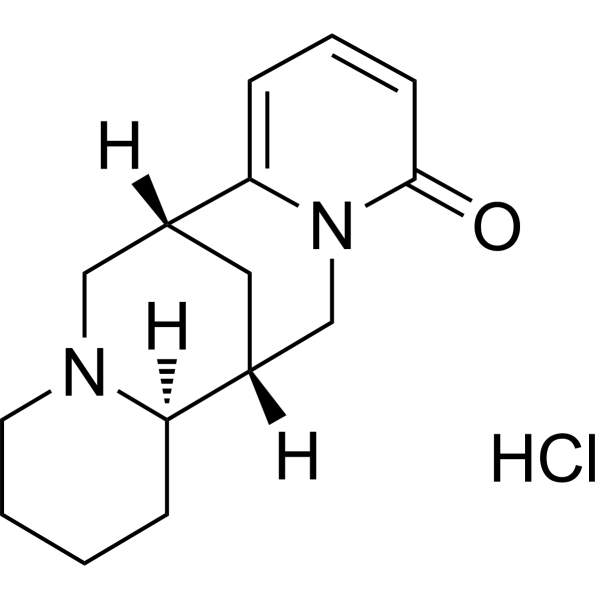
- HY-152552
-
|
|
α-synuclein
|
Neurological Disease
|
|
α-Synuclein inhibitor 8 is an active inhibitor of α-Synuclein with an IC50 value of 2.5 µM. α-Synuclein inhibitor 8 has highly inhibition on the aggregation and disaggregation of α-Synuclein fibers. α-Synuclein inhibitor 8 reduces the formation of inclusions in neurons that can repairs damage neurons and improves Parkinson’s disease (PD)-like symptoms. α-Synuclein inhibitor 8 has high antioxidant activity and low cytotoxicity .
|
-

- HY-149243
-
|
|
Cholinesterase (ChE)
|
Neurological Disease
|
|
BChE-IN-16 (compound 87) is a highly potent BChE inhibitor with an IC50 of 3.8 nM for hBChE. BChE-IN-16 has low cytotoxicity, potential CNS permeability, unique adaptability and can be used in Alzheimer's disease (AD) research.
|
-

- HY-N9587
-
|
|
Apoptosis
|
Neurological Disease
|
|
Tricin 7-O-β-D-glucopyranoside is a potent and orally active neuroprotective agent. Tricin 7-O-β-D-glucopyranoside induces Apoptosis. Tricin 7-O-β-D-glucopyranoside decreases the expression of TNF-α induced phosphor-κB-α, phosphor-NF-κB, HMGB1 .
|
-
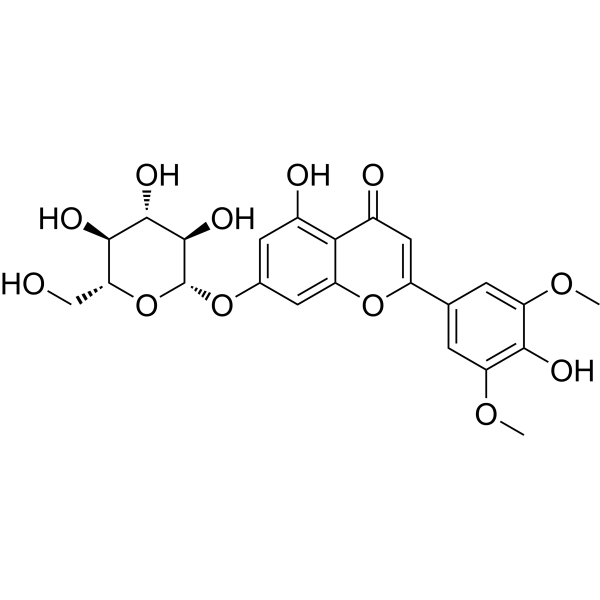
- HY-157441
-
|
|
Cholinesterase (ChE)
Amyloid-β
|
Neurological Disease
|
|
AChE/Aβ-IN-4 is a dual inhibitor of acetylcholinesterase (AChE) and β-amyloid (Aβ) aggregation, with the IC50 values of 1.72 ± 0.18 μM and 1.42 ± 0.3 μM, respectively. AChE/Aβ-IN-4 plays an impotant role in neurological disorders, such as Alzheimer’s disease .
|
-
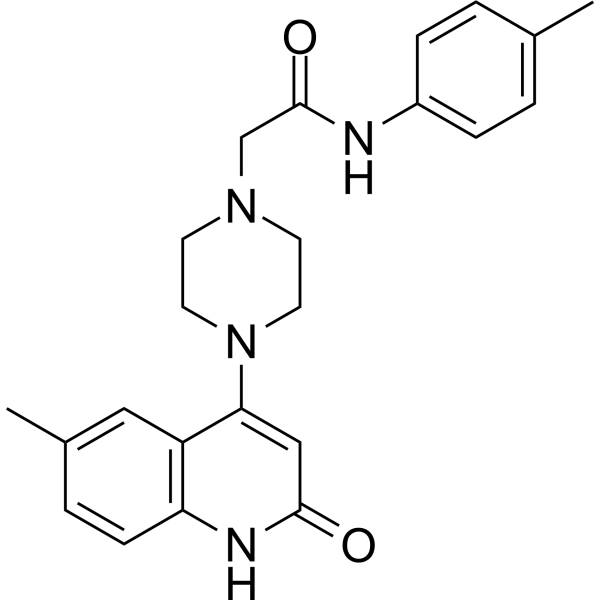
- HY-13409
-
|
|
5-HT Receptor
|
Neurological Disease
Metabolic Disease
|
|
SB 242084 is a selective, competitive and high-affinity (pKi=9.0) 5-HT2C receptor antagonist (crosses the blood-brain barrier). SB 242084 increases basal activity of dopaminergic neurons in the ventral tegmental area (VTA) of the midbrain and dopamine release in the vomeronasal nucleus. SB 242084 also increases mitochondrial gene expression and oxidative metabolism via 5-HT2A receptor. SB 242084 has good research potential in the negative symptoms of anxiety, depression and schizophrenia, as well as in acute organ damage .
|
-

- HY-13409A
-
|
|
5-HT Receptor
|
Neurological Disease
Metabolic Disease
|
|
SB 242084 dihydrochloride is a selective, competitive and high-affinity (pKi=9.0) 5-HT2C receptor antagonist (crosses the blood-brain barrier). SB 242084 dihydrochloride increases basal activity of dopaminergic neurons in the ventral tegmental area (VTA) of the midbrain and dopamine release in the vomeronasal nucleus. SB 242084 dihydrochloride also increases mitochondrial gene expression and oxidative metabolism via 5-HT2A receptor. SB 242084 dihydrochloride has good research potential in the negative symptoms of anxiety, depression and schizophrenia, as well as in acute organ damage .
|
-

- HY-13977A
-
|
|
Apoptosis
|
Neurological Disease
|
|
PKR-IN-C16 (Compound C16) is a specific double-stranded RNA-dependent protein kinase (PKR) inhibitor. PKR-IN-C16 shows promising neuroprotective properties and can rescue acute brain lesions .
|
-
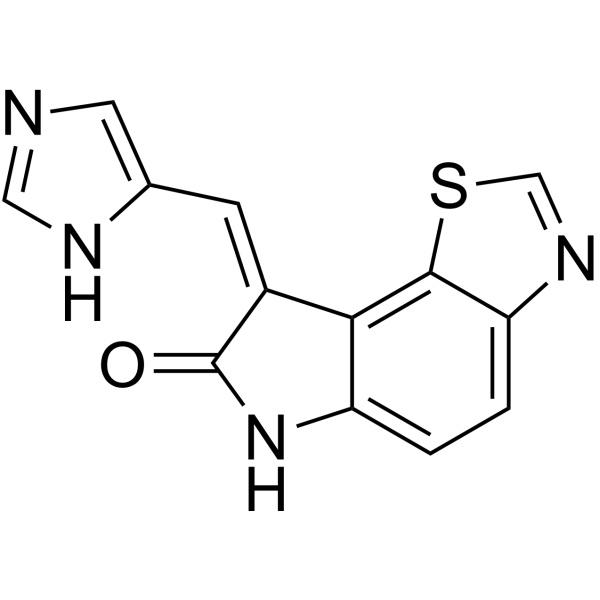
- HY-146315
-
|
|
Cholinesterase (ChE)
Monoamine Oxidase
|
Neurological Disease
|
|
AChE/BChE-IN-6 (compound 22) is a potent dual AChE/BChE inhibitor with IC50 values of 0.809 µM, 2.248 µM and > 100 µM for hBChE, hAChE and hMAO-B, respectively. AChE/BChE-IN-6 penetrates the blood-brain barrier (BBB). AChE/BChE-IN-6 can be used for Alzheimer’s disease (AD) research .
|
-
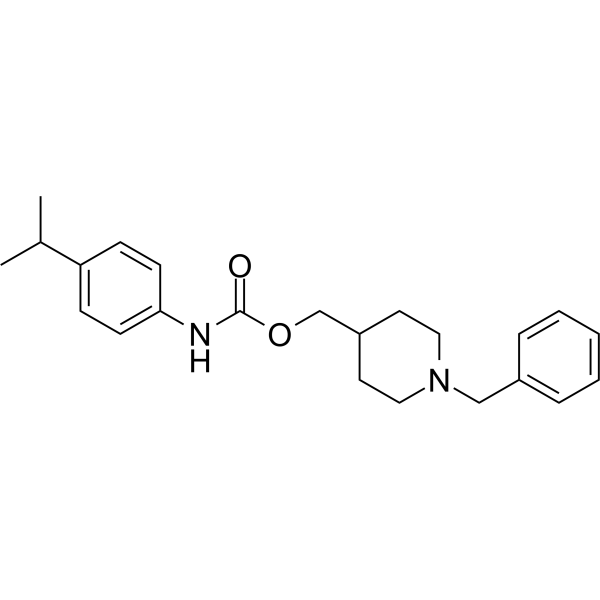
- HY-151885
-
|
|
Cholinesterase (ChE)
Monoamine Oxidase
|
Neurological Disease
|
|
Dual AChE-MAO B-IN-3 (compound C10) is a potent dual AChE/MAO-B inhibitior, with IC50 values of 0.58 and 0.41 μM, respectively. Dual AChE-MAO B-IN-3 is a dual-binding inhibitor bound to both the catalytic anionic site and peripheral anionic site of AChE. Dual AChE-MAO B-IN-3 can be used for Alzheimer’s disease (AD) research .
|
-
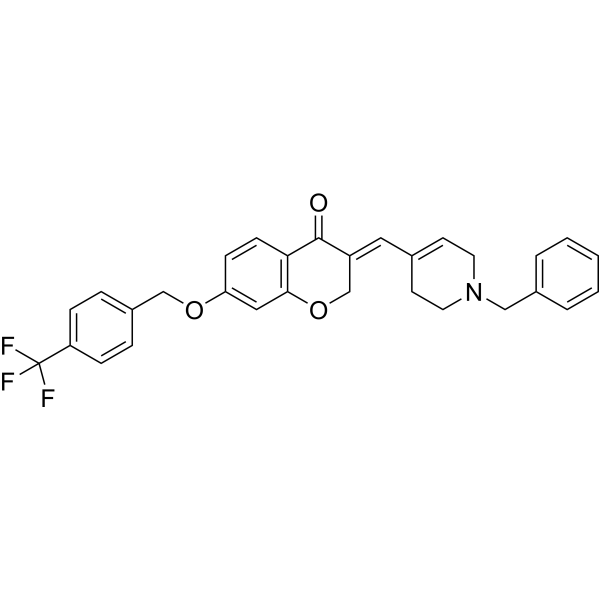
- HY-N3359
-
-

- HY-N3359B
-
|
D-Lupanine hydrochloride
|
nAChR
|
Neurological Disease
|
|
Lupanine (D-Lupanine) hydrochloride is a natural ketonic derivative of Sparteine ((+)-Sparteine (HY-W008350)) with a ganglioplegic activity. Lupanine hydrochloride shows binding affinity for nicotinic receptor (nAChR) with a Ki value of 500 nM .
|
-

- HY-148948
-
|
|
NAMPT
|
Neurological Disease
|
|
NAMPT activator-3, a NAT derivative, is a NAMPT activator with an EC50 of 2.6 μM and a KD of 132 nM. NAMPT activator-3 effectively protects cultured cells from FK866 (HY-50876)-mediated toxicity. NAMPT activator-3 exhibits strong neuroprotective efficacy in a chemotherapy-induced peripheral neuropathy (CIPN) mouse model without any overt toxicity .
|
-

- HY-149287
-
|
|
Cholinesterase (ChE)
|
Neurological Disease
|
|
hAChE/hBACE-1-IN-1 (compounds 5d) is an orally active inhibitor of hAChE with blood-brain permeability. hAChE/hBACE-1-IN-1 inhibits hAChE and hBACE-1 with IC50 values of 0.076 and 0.23 μM, respectively. hAChE/hBACE-1-IN-1 inhibits Aβ1-42 aggregation and improves mouse learning and memory ability. hAChE/hBACE-1-IN-1 can be used to research in Alzheimer's disease .
|
-
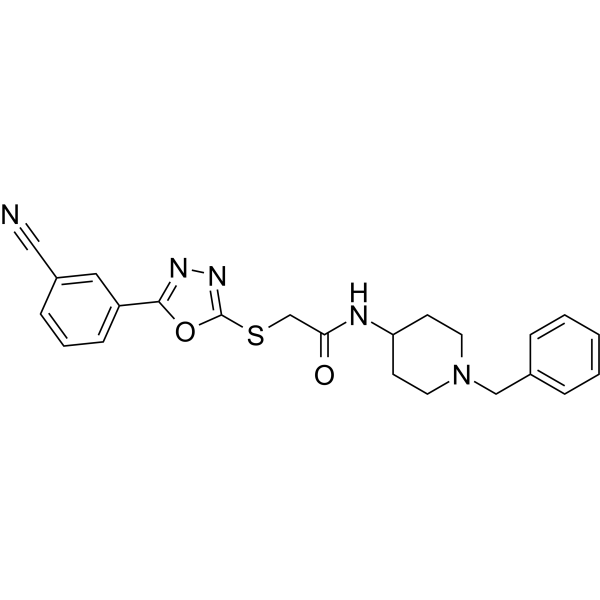
- HY-149288
-
|
|
Cholinesterase (ChE)
Beta-secretase
Amyloid-β
|
|
|
hAChE/hBACE-1-IN-2 is a potent, orally active, blood-brain barrier transboundary triple inhibitor of hAChE, hBChE, and HACE-1 with IC50s of 0.113 μM, 1.48 μM and 0.38 μM, respectively. hAChE/hBACE-1-IN-2 has antioxidant activity. hAChE/hBACE-1-IN-2 also inhibits Aβ11-42 aggregation. hAChE/hBACE-1-IN-2 can be used to study Alzheimer's disease .
|
-
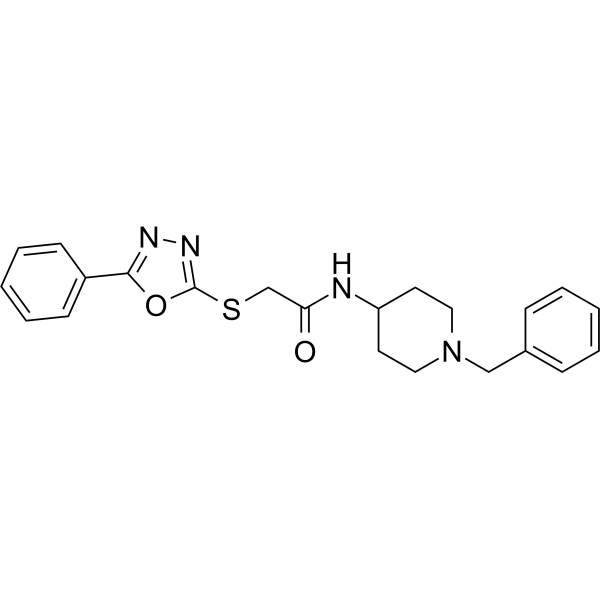
- HY-162050
-
|
|
Sirtuin
|
Neurological Disease
|
|
8AQ?Cu?5Iu is an activator of SIRT1. 8AQ?Cu?5Iu exhibits neuroprotective effects by
modulating the SIRT1/3-FOXO3a signaling pathway. 8AQ?Cu?5Iu can used in study attenuating neurodegenerative diseases .
|
-

- HY-B0124
-
|
AD 810; CI 912
|
Carbonic Anhydrase
Apoptosis
|
Neurological Disease
|
|
Zonisamide (AD 810) is an orally active carbonic anhydrase inhibitor, with Kis of 35.2 and 20.6 nM for hCA II and hCA V, respectively. Zonisamide exerts neuroprotective effects through anti-apoptosis and upregulating MnSOD levels. Zonisamide also increases the expression of Hrd1, thereby improving cardiac function in AAC rats. Zonisamide can be used in studies of seizure, parkinson’s disease and cardiac hypertrophy .
|
-

- HY-B0124A
-
|
AD 810 sodium; CI 912 sodium
|
Carbonic Anhydrase
Apoptosis
|
Cardiovascular Disease
Neurological Disease
|
|
Zonisamide (AD 810) sodium is an orally active carbonic anhydrase inhibitor, with Kis of 35.2 and 20.6 nM for hCA II and hCA V, respectively. Zonisamide sodium exerts neuroprotective effects through anti-apoptosis and upregulating MnSOD levels. Zonisamide sodium also increases the expression of Hrd1, thereby improving cardiac function in AAC rats. Zonisamide sodium can be used in studies of seizure, parkinson’s disease and cardiac hypertrophy .
|
-

- HY-123962
-
|
|
Others
|
Metabolic Disease
|
|
G6PD activator AG1 is a potent and selective glucose-6-phosphate dehydrogenase (G6PD) activator with an EC50 of 3 µΜ . G6PD activator AG1 reduces hemolysis of human erythrocytes .
|
-
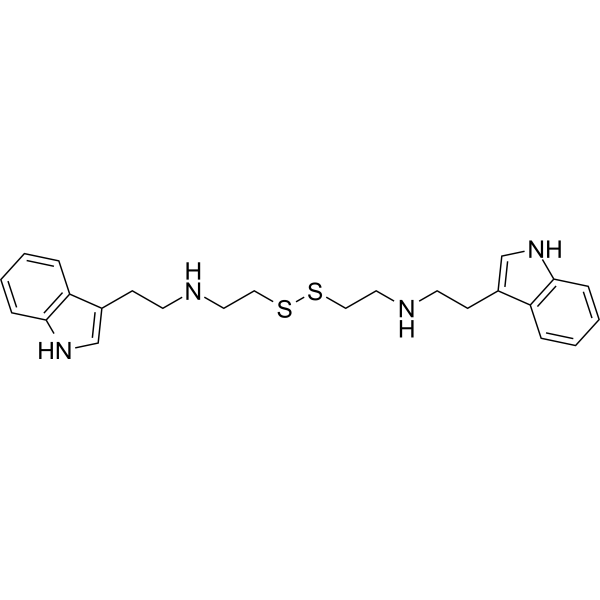
- HY-144635
-
-
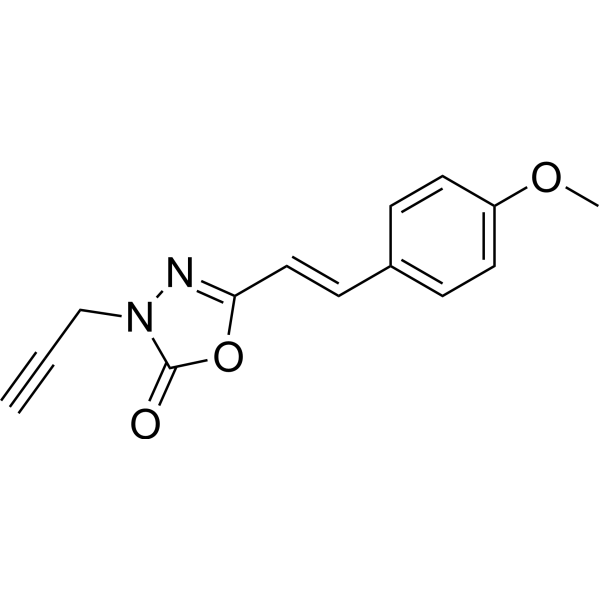
- HY-112555
-
-

- HY-14541
-
|
LY170053
|
5-HT Receptor
Dopamine Receptor
mAChR
Adrenergic Receptor
Autophagy
Mitophagy
Apoptosis
|
Neurological Disease
Cancer
|
|
Olanzapine (LY170053) is a selective, orally active monoaminergic antagonist with high affinity binding to serotonin H1, 5HT2A/2C, 5HT3, 5HT6 (Ki=7, 4, 11, 57, and 5 nM, respectively), dopamine D1-4 (Ki=11 to 31 nM), muscarinic M1-5 (Ki=1.9-25 nM), and adrenergic α1 receptor (Ki=19 nM). Olanzapine is an atypical antipsychotic .
|
-
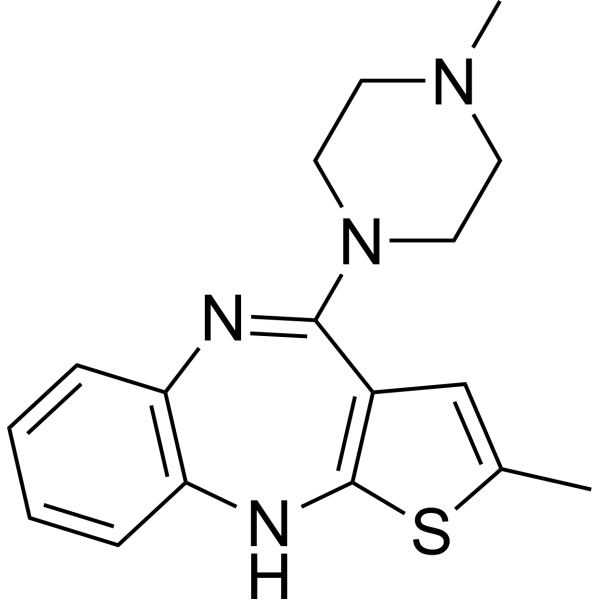
- HY-103472
-
|
|
Formyl Peptide Receptor (FPR)
|
Neurological Disease
|
|
FPR-A14 is a potent formyl peptide receptor (FPR) agonist. FPR-A14 is a potent activator of neutrophil Ca 2+ mobilization and chemotaxis with EC50s of 630 nM and 42 nM, respectively. FPR-A14 induces cell differentiation .
|
-

- HY-136910
-
|
|
Deubiquitinase
|
Cancer
|
|
USP7-IN-7 (compound 124) is a USP7 inhibitor with an IC50 value <10 nM. USP7-IN-7 shows cytotoxicity against p53-mutant cancer cell lines, p53 wild-type blood cancer and neuroblastoma cell lines with low nanomolar values. USP7-IN-7 can be used for cancer research .
|
-
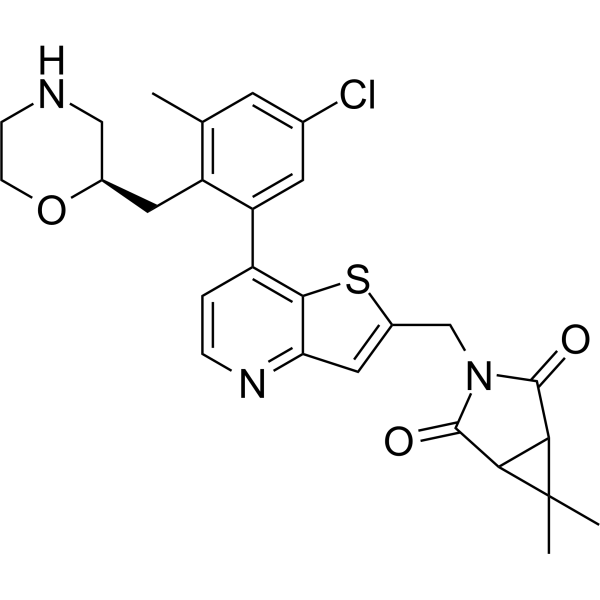
- HY-145848
-
|
|
Estrogen Receptor/ERR
|
Neurological Disease
|
|
ERRγ agonist-1 is a potent ERRγ agonist. ERRγ agonist-1 increases transcriptional activities of ERRγ. ERRγ agonist-1 has the potential for the research of neuropsychological disorders .
|
-
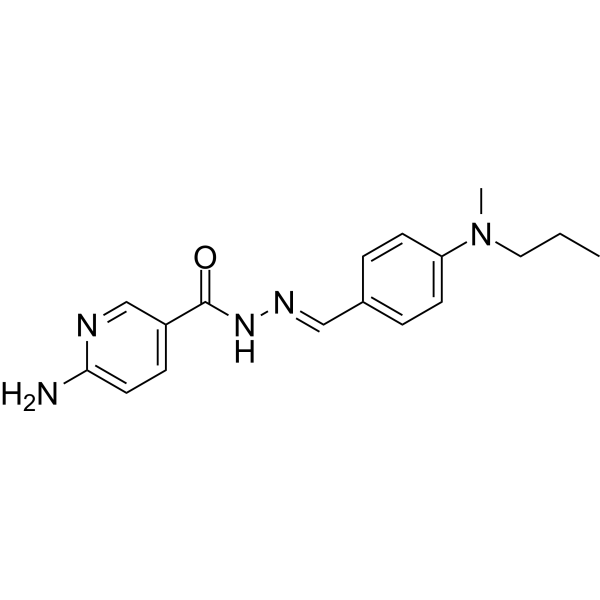
- HY-151386
-
|
|
Cholinesterase (ChE)
|
Neurological Disease
|
|
BChE-IN-13 (Compound 17c) is an orally active, potent and selective Butyrylcholinesterase (BChE) inhibitor with IC50s of 0.22 and 0.016 μM for eqBChE and hBChE, respectively. BChE-IN-13 can improve memory and cognitive impairments, and be used in Alzheimer’s disease (AD) research .
|
-
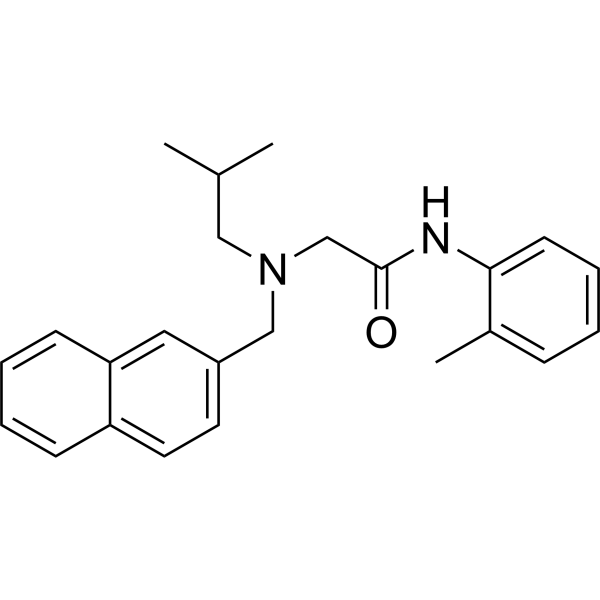
- HY-14649G
-
|
Vitamin A acid; all-trans-Retinoic acid; ATRA
|
RAR/RXR
|
Cancer
|
|
Retinoic acid (Vitamin A acid) (GMP) is Retinoic acid (HY-14649) produced by using GMP guidelines. GMP small molecules works appropriately as an auxiliary reagent for cell therapy manufacture. Retinoic acid is an agonist of RAR nuclear receptors [5] .
|
-
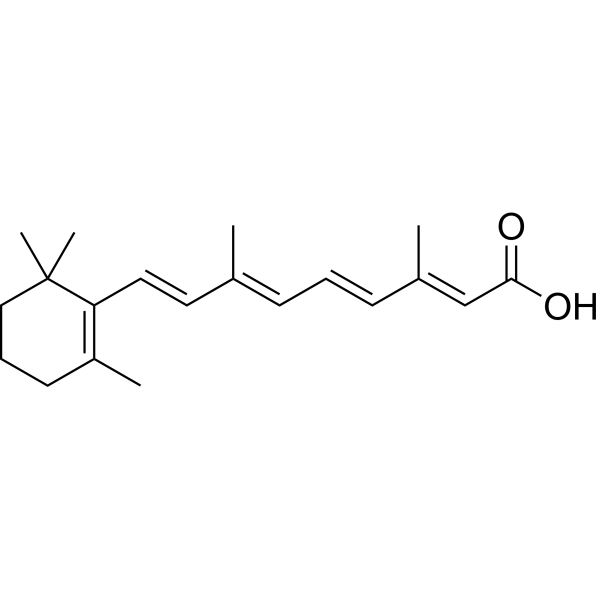
- HY-B0988
-
-
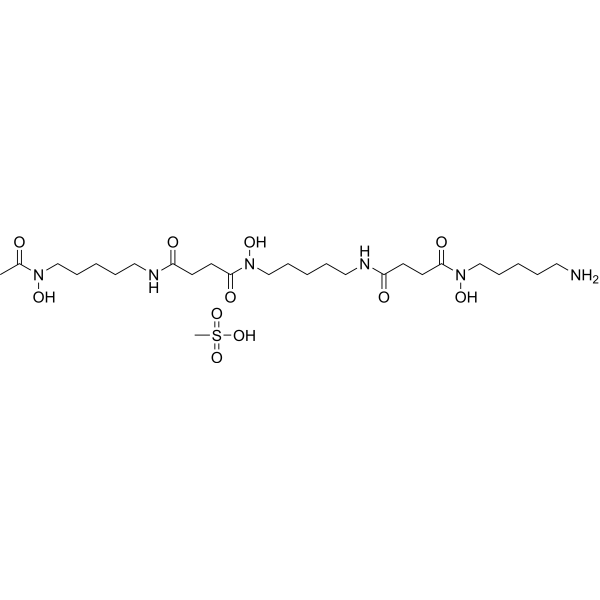
- HY-146351
-
|
|
HDAC
|
Neurological Disease
|
|
HDAC-IN-38 (compound 13) is a potent HDAC inhibitor. HDAC-IN-38 shows similar micro-molar inhibitory activity toward HDAC1, 2, 3, 5, 6, and 8. HDAC-IN-38 increases cerebral blood flow (CBF), attenuates cognitive impairment, and improves hippocampal atrophy. HDAC-IN-38 also increases the level of histone acetylation (H3K14 or H4K5) .
|
-
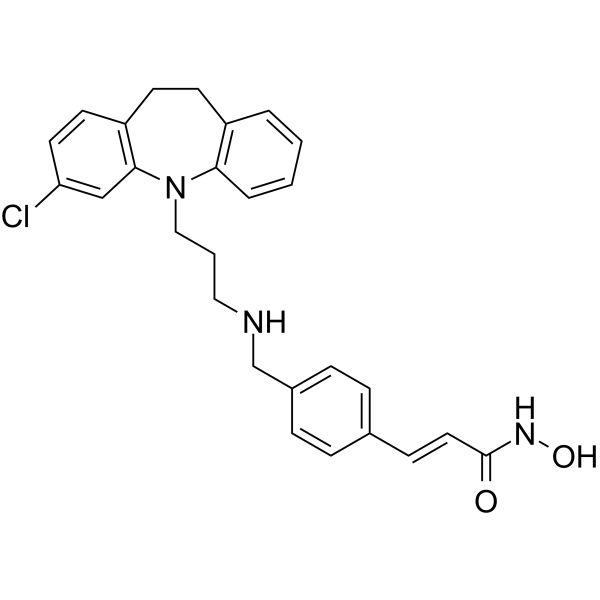
- HY-B1625
-
-
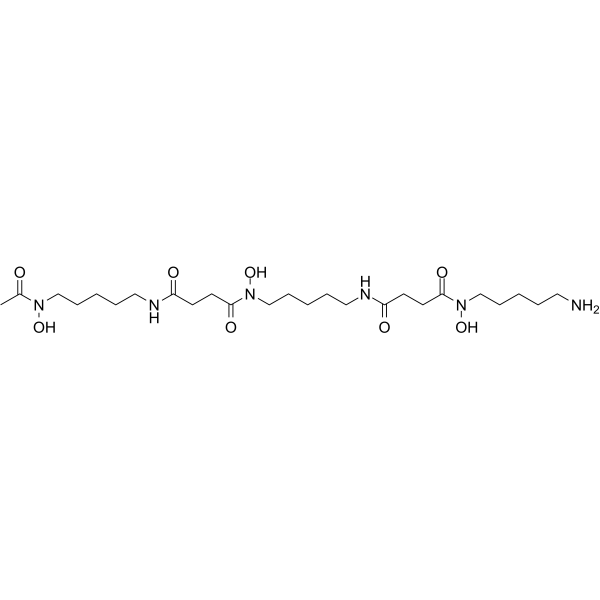
- HY-151388
-
|
|
Monoamine Oxidase
COMT
|
Neurological Disease
|
|
hMAO-B/MB-COMT-IN-1 is a dual MAO-B/MB-COMT inhibitor (IC50s: 2.5 μΜ for hMAO-B, 3.84 μΜ for MB-COMT). hMAO-B/MB-COMT-IN-1 protects cells against oxidative damage. hMAO-B/MB-COMT-IN-1 can be used in the research of neurodegeneration disease, such as Parkinson’s Disease (PD) .
|
-
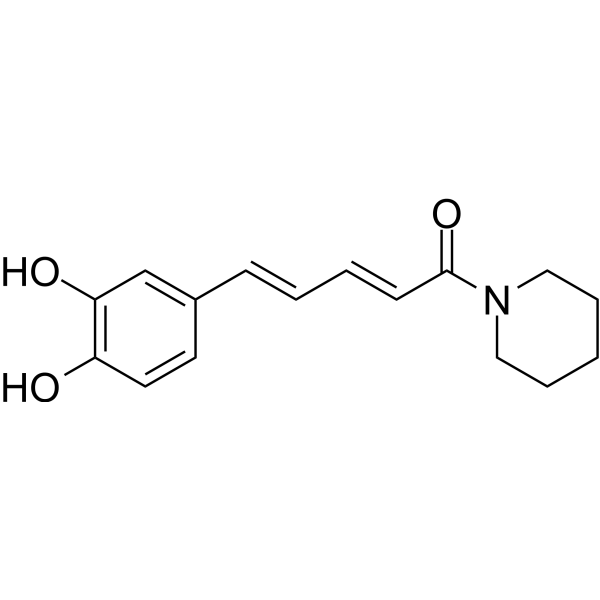
- HY-151390
-
|
|
Monoamine Oxidase
COMT
|
Neurological Disease
|
|
hMAO-B/MB-COMT-IN-2 is a dual MAO-B/MB-COMT inhibitor (IC50s: 4.27 μΜ for hMAO-B, 2.69 μΜ for MB-COMT). hMAO-B/MB-COMT-IN-2 protects cells against oxidative damage. hMAO-B/MB-COMT-IN-2 can be used in the research of neurodegeneration disease, such as Parkinson’s Disease (PD) .
|
-
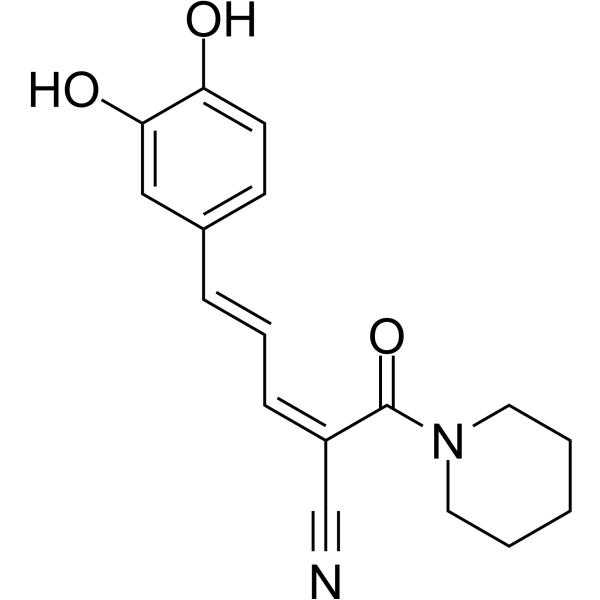
- HY-14942A
-
|
RTA 744; WP 744; WP 769 hydrochloride
|
Apoptosis
|
Cancer
|
|
Berubicin hydrochloride (RTA 744) is a Doxorubicin (HY-15142A) analogue. Berubicin hydrochloride triggers apoptosis and cell killing in NB cells by activating proapoptotic mediators. Berubicin hydrochloride has proapoptotic and anti-leukemia activities. Berubicin hydrochloride can be used for cancer research .
|
-
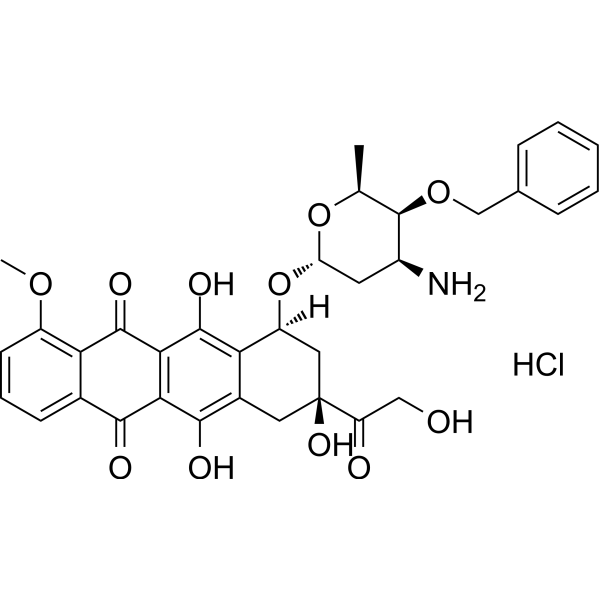
- HY-116107
-
|
|
Necroptosis
|
Cancer
|
|
AG311 is an anticancer and antimetastatic agent. AG311 induces rapid necrosis in numerous cancer cell lines .
|
-
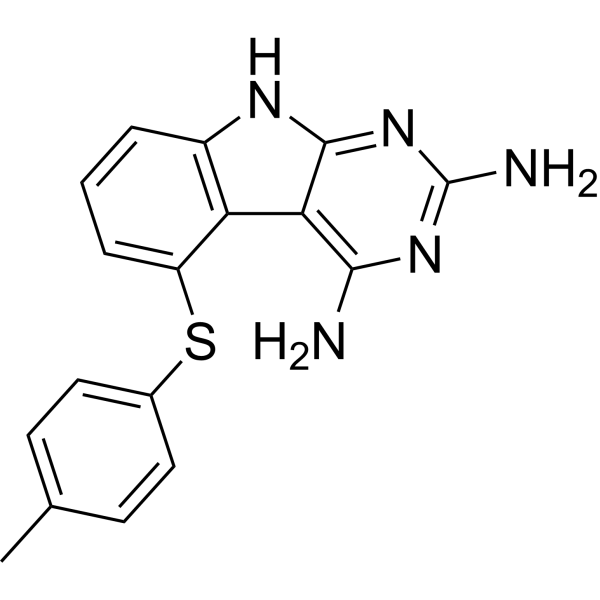
- HY-10475G
-
|
CD336; NSC608001; Ro 40-6055
|
RAR/RXR
|
Cancer
|
|
AM580 (CD336) (GMP) is AM580 (HY-10475) produced by using GMP guidelines. GMP small molecules works appropriately as an auxiliary reagent for cell therapy manufacture. AM580 is a selective RARα agonist .
|
-
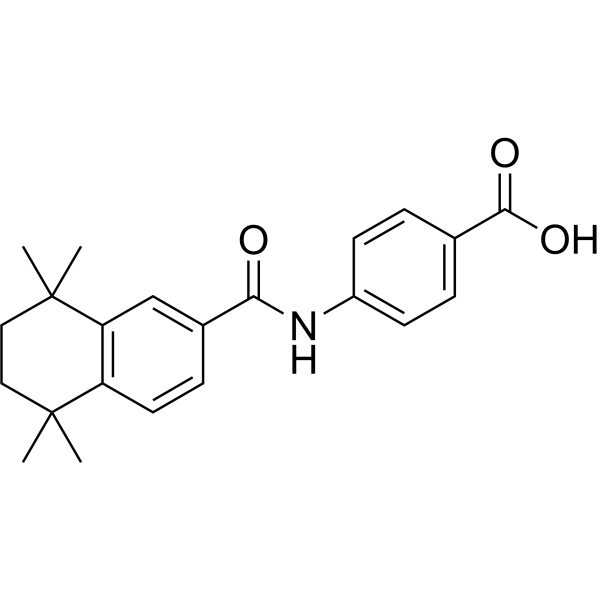
- HY-14930A
-
-

- HY-14930
-
-

- HY-145833A
-
|
|
Epoxide Hydrolase
Cholinesterase (ChE)
|
Neurological Disease
Cancer
|
|
sEH/AChE-IN-4 (compound (+)-15) is a potent and BBB-penetrated dual inhibitor of sEH (soluble epoxide hydrolase) and AChE (acetylcholinesterase), with IC50 values of 3.1 nM (hsEH), 1660 nM (hAChE), 179 nM (hBChE, human butyrylcholinesterase), 14.5 nM (msEH), and 102 nM (mAChE), respectively .
|
-

- HY-145833
-
|
|
Epoxide Hydrolase
Cholinesterase (ChE)
|
Neurological Disease
Cancer
|
|
sEH/AChE-IN-3 (compound (−)-15) is a potent and BBB-penetrated dual inhibitor of sEH (soluble epoxide hydrolase) and AChE (acetylcholinesterase), with IC50 values of 0.4 nM (hsEH), 1.94 nM (hAChE), 615 (hBChE, human butyrylcholinesterase), 4.3 nM (msEH), and 2.61 nM (mAChE), respectively .
|
-
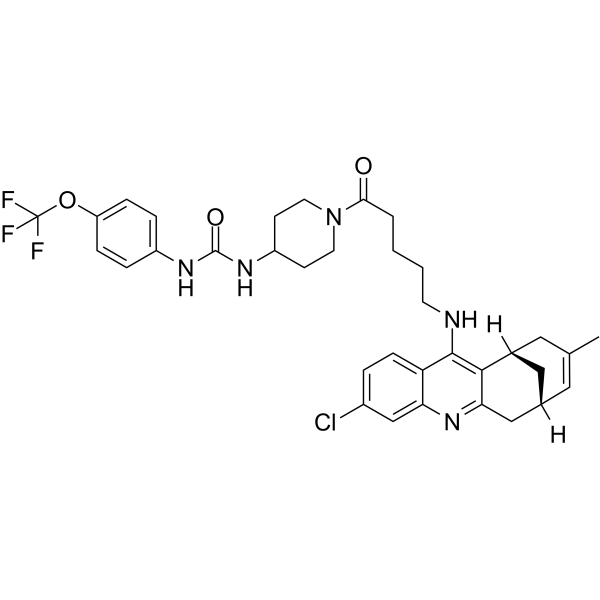
- HY-134050
-
|
Apt-1
|
RIP kinase
Autophagy
Apoptosis
Beclin1
Necroptosis
|
Inflammation/Immunology
|
|
Apostatin-1 (Apt-1) is a potent TRADD inhibitor. Apostatin-1 can bind with TRADD-N (KD=2.17 μM), disrupting its binding to both TRADD-C and TRAF2. Apostatin-1 modulates the ubiquitination of RIPK1 and beclin 1. Apostatin-1 blocks apoptosis and restores cellular homeostasis by activating autophagy in cells with accumulated mutant tau, α-synuclein, or huntingtin .
|
-
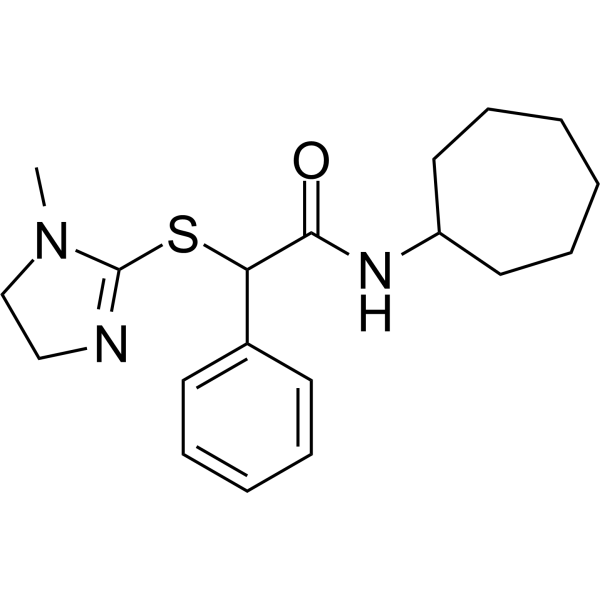
- HY-149234
-
|
|
Monoamine Oxidase
|
Neurological Disease
|
|
MAO-B-IN-18 is a potent and selective MAO B inhibitor with IC50s of 52 nM and 14 μM for hMAO B and hMAO A, respectively. MAO-B-IN-18 enables promising cytoprotective effects against hydrogen peroxide insults in neuroblastoma and astrocytes cultures .
|
-
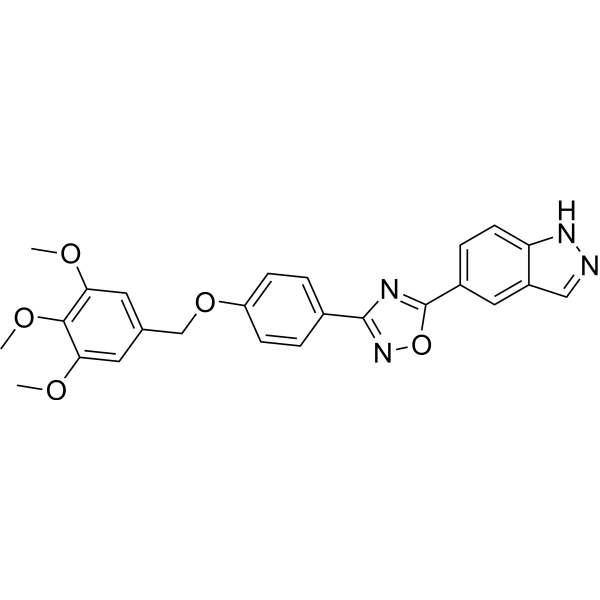
- HY-153904
-
|
|
Casein Kinase
|
Neurological Disease
|
|
Casein kinase 1δ-IN-5 is a potent and selective protein kinase CK-1δ inhibitor with an IC50 of 47 nM. Casein kinase 1δ-IN-5 shows neuroprotective and anti-inflammatory properties both in vitro. Casein kinase 1δ-IN-5 has the potential for neurodegenerative diseases research.
|
-
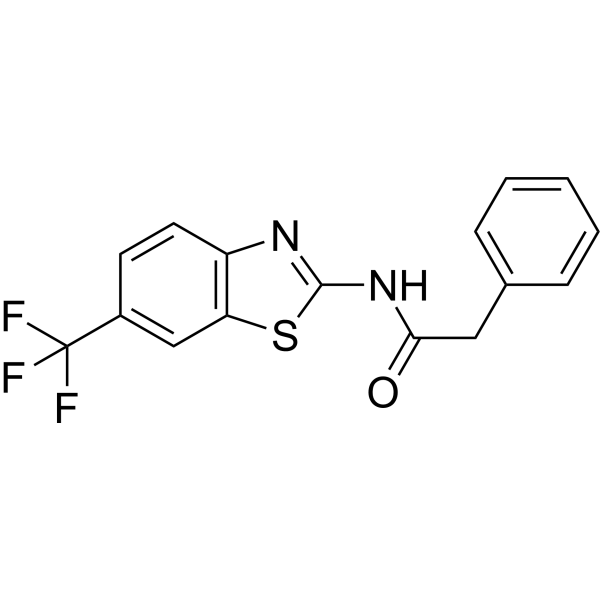
- HY-153905
-
|
|
Casein Kinase
|
Neurological Disease
|
|
Casein kinase 1δ-IN-6 is a potent and selective protein kinase CK-1δ inhibitor with an IC50 of 23 nM. Casein kinase 1δ-IN-6 shows neuroprotective and anti-inflammatory properties both in vitro and in vivo. Casein kinase 1δ-IN-6 is a promising drug candidate and can be used for neurodegenerative diseases research.
|
-
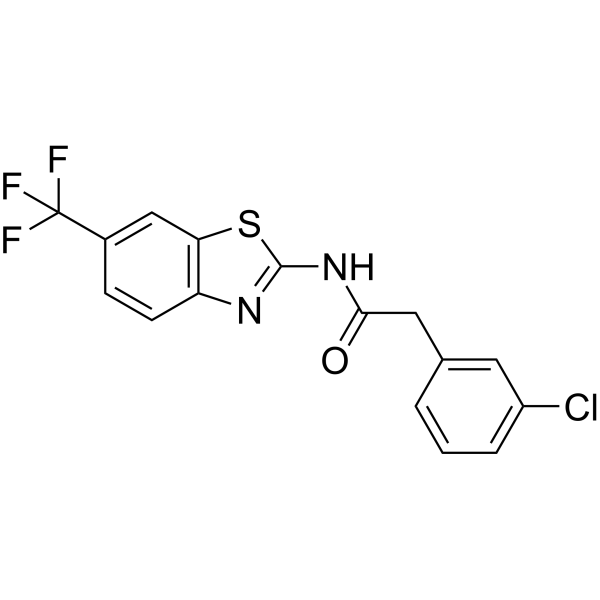
- HY-163031
-
|
|
Monoamine Oxidase
|
Neurological Disease
|
|
MAO-B-IN-28 (compound 10e) is a potent hMAO-B inhibitor with an IC50 of 1.9±0.5 nM. MAO-B-IN-28 can be used as a candidate for neurodegenerative diseases research .
|
-
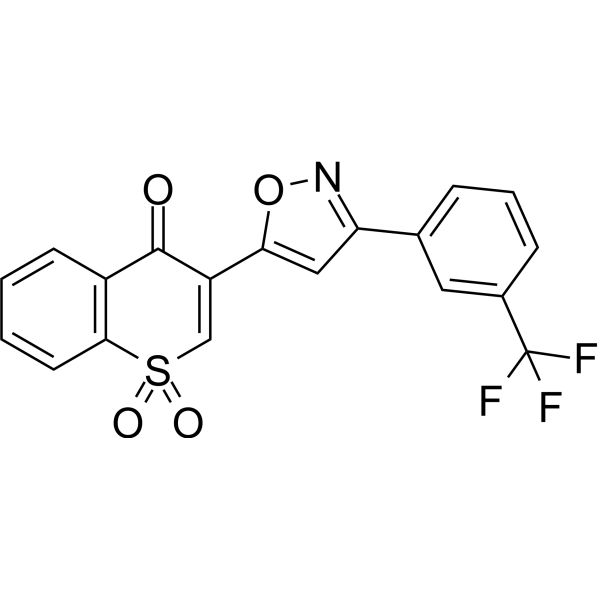
- HY-146314
-
|
|
Monoamine Oxidase
Amyloid-β
|
Neurological Disease
|
|
MAO-B-IN-9 (compound 16) is a potent, selective, BBB-penetrated, irreversible and time-dependent MAO-B (monoamine oxidase B) inhibitor, with an IC50 of 0.18 μM. MAO-B-IN-9 prevents Aβ1-42-induced neuronal cell death. MAO-B-IN-9 shows neuroprotective effects, which may be the result of its Aβ1-42 anti-aggregation effects . MAO-B-IN-9 is a click chemistry reagent, itcontains an Alkyne group and can undergo copper-catalyzed azide-alkyne cycloaddition (CuAAc) with molecules containing Azide groups.
|
-

- HY-B1081
-
|
6-Hydroxydopamine hydrochloride; 6-OHDA hydrochloride
|
Dopamine Receptor
Autophagy
Mitophagy
COX
PGE synthase
Interleukin Related
p38 MAPK
Apoptosis
Caspase
|
Neurological Disease
Cancer
|
|
Oxidopamine (6-OHDA) hydrochloride is an antagonist of the neurotransmitter dopamine. Oxidopamine hydrochloride is a widely used neurotoxin and selectively destroys dopaminergic neurons. Oxidopamine hydrochloride promotes COX-2 activation, leading to PGE2 synthesis and pro-inflammatory cytokine IL-1β secretion. Oxidopamine hydrochloride can be used for the research of Parkinson’s disease (PD), attention-deficit hyperactivity disorder (ADHD), and Lesch-Nyhan syndrome .
|
-

- HY-B1081A
-
|
6-Hydroxydopamine hydrobromide; 6-OHDA hydrobromide
|
Dopamine Receptor
Autophagy
Mitophagy
COX
PGE synthase
Interleukin Related
p38 MAPK
Apoptosis
Caspase
|
Neurological Disease
Cancer
|
|
Oxidopamine (6-OHDA) hydrobromide is an antagonist of the neurotransmitter dopamine. Oxidopamine hydrobromide is a widely used neurotoxin and selectively destroys dopaminergic neurons. Oxidopamine hydrobromide promotes COX-2 activation, leading to PGE2 synthesis and pro-inflammatory cytokine IL-1β secretion. Oxidopamine hydrobromide can be used for the research of Parkinson’s disease (PD), attention-deficit hyperactivity disorder (ADHD), and Lesch-Nyhan syndrome .
|
-

- HY-146313
-
|
|
Cholinesterase (ChE)
|
Neurological Disease
|
|
BChE-IN-7 (compound 13) is a potent, selective, BBB-penetrated and reversible AChE and BChE inhibitor, with an IC50 of 0.06 μM (BChE). BChE-IN-7 can protect neuronal-like cells from toxic Aβ-species .
|
-
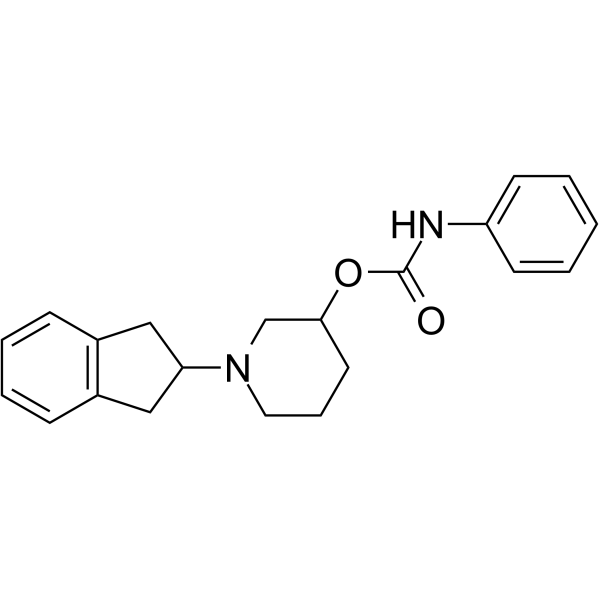
- HY-110122
-
|
|
mGluR
|
Neurological Disease
|
|
AZ 12216052 is a mGluR8 positive allosteric modulator, and helps mGluR8 modulate signaling inputing to retinal ganglion cells. AZ 12216052 exhibits antianxiety effect .
|
-
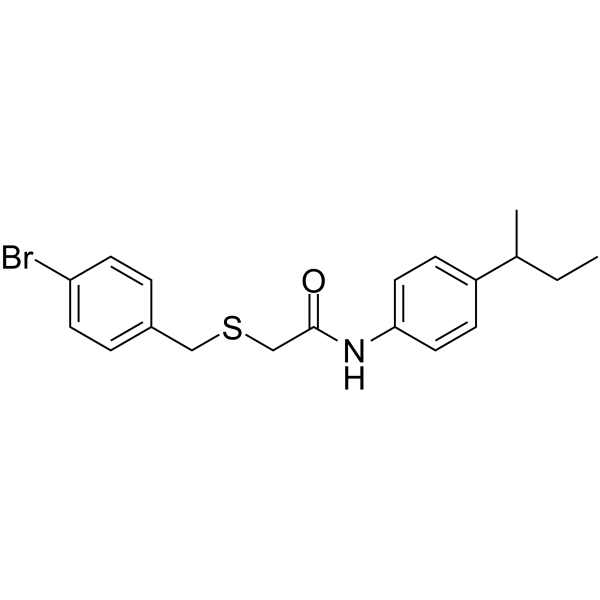
- HY-151335
-
|
|
HSP
|
Cancer
|
|
KU-177 is a potent inhibitor of Hsp90 ATPase homologue 1 (Aha1), ablates Aha1-driven enhancement of Hsp90-dependent tau aggregation. KU-177 also disrupts Aha1/Hsp90 interactions (IC50=4.08 μM) without inhibition of Hsp90’s ATPase activity. KU-177 can be used for tauopathies research .
|
-
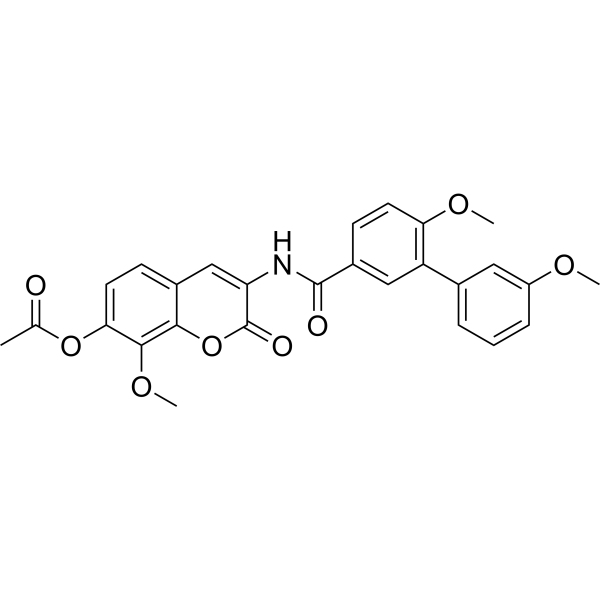
- HY-A0068
-
|
Gold thioglucose
|
NF-κB
HIV
Reactive Oxygen Species
|
Infection
Inflammation/Immunology
Cancer
|
|
Aurothioglucose (Gold thioglucose), containing monovalent gold ion, is a potent active-site inhibitor of TrxR1 (thioredoxin reductase 1), with an IC50 of 65 nM. Aurothioglucose inhibits the DNA binding of NF-κB in vitro. Aurothioglucose shows anti-HIV and anti-rheumatic activities .
|
-

| Cat. No. |
Product Name |
Type |
-
- HY-10475G
-
|
CD336 (GMP); NSC608001 (GMP); Ro 40-6055 (GMP)
|
Fluorescent Dye
|
|
AM580 (CD336) (GMP) is AM580 (HY-10475) produced by using GMP guidelines. GMP small molecules works appropriately as an auxiliary reagent for cell therapy manufacture. AM580 is a selective RARα agonist .
|
-
- HY-D1684
-
|
|
Fluorescent Dyes/Probes
|
|
DCDAPH (Compound 2c) is a novel smart NIRF probe for detection of β-amyloid (Aβ) plaques (λex/λem=597/665 nm in PBS). DCDAPH shows high affinity for Aβ aggregates (Ki=37 nM, Kd=27 nM). DCDAPH shows good blood brain barrier permeation and can meet most of the requirements for the detection of Aβ plaques both in vitro and in vivo .
|
-
- HY-151615
-
|
|
Fluorescent Dyes/Probes
|
|
DCI-Br-3 is a rapid, highly sensitive, and selective probe to monitor thiols in the epileptic brain. (λex=537 nm, λem=675 nm).DCI-Br-3 can effectively cross the blood-brain barrier (BBB) .
|
-
- HY-15141G
-
|
Antibiotic AM-2282 (GMP); STS (GMP); AM-2282 (GMP)
|
Fluorescent Dye
|
|
Staurosporine (AM-2282) (GMP) is Staurosporine (HY-15141) produced by using GMP guidelines. GMP small molecules works appropriately as an auxiliary reagent for cell therapy manufacture. Staurosporine is a potent, ATP-competitive and non-selective inhibitor of protein kinases [5].
|
-
- HY-14649G
-
|
Vitamin A acid (GMP); all-trans-Retinoic acid (GMP); ATRA (GMP)
|
Fluorescent Dye
|
|
Retinoic acid (Vitamin A acid) (GMP) is Retinoic acid (HY-14649) produced by using GMP guidelines. GMP small molecules works appropriately as an auxiliary reagent for cell therapy manufacture. Retinoic acid is an agonist of RAR nuclear receptors [5] .
|
| Cat. No. |
Product Name |
Type |
-
- HY-10475G
-
|
CD336 (GMP); NSC608001 (GMP); Ro 40-6055 (GMP)
|
Biochemical Assay Reagents
|
|
AM580 (CD336) (GMP) is AM580 (HY-10475) produced by using GMP guidelines. GMP small molecules works appropriately as an auxiliary reagent for cell therapy manufacture. AM580 is a selective RARα agonist .
|
-
- HY-15141G
-
|
Antibiotic AM-2282 (GMP); STS (GMP); AM-2282 (GMP)
|
Biochemical Assay Reagents
|
|
Staurosporine (AM-2282) (GMP) is Staurosporine (HY-15141) produced by using GMP guidelines. GMP small molecules works appropriately as an auxiliary reagent for cell therapy manufacture. Staurosporine is a potent, ATP-competitive and non-selective inhibitor of protein kinases [5].
|
-
- HY-14649G
-
|
Vitamin A acid (GMP); all-trans-Retinoic acid (GMP); ATRA (GMP)
|
Biochemical Assay Reagents
|
|
Retinoic acid (Vitamin A acid) (GMP) is Retinoic acid (HY-14649) produced by using GMP guidelines. GMP small molecules works appropriately as an auxiliary reagent for cell therapy manufacture. Retinoic acid is an agonist of RAR nuclear receptors [5] .
|
| Cat. No. |
Product Name |
Target |
Research Area |
-
- HY-106224B
-
|
Hypocretin-1 (human, rat, mouse) (acetate)
|
Orexin Receptor (OX Receptor)
|
Neurological Disease
|
|
Orexin A (Hypocretin-1) (human, rat, mouse) acetate is a hypothalamic neuropeptide with analgesic properties (crosses the blood-brain barrier). Orexin A (human, rat, mouse) acetate is also an OX1R agonist that induces the expression of BDNF and TH proteins in SH-SY5Y cells in a time- and dose-dependent manner. Orexin A (human, rat, mouse) acetate can be used in studies of appetite regulation, neurodegenerative diseases and modulation of injurious messaging .
|
-
- HY-P5902
-
-
- HY-P3275
-
|
Aβ(17-40)
|
Amyloid-β
|
Neurological Disease
|
|
β-Amyloid (17-40) (Aβ(17-40)) is a fragment of Amyloid-β peptide that has shown neurotoxic activities in SH-SY5Y and IMR-32 cells. β-Amyloid (17-40) can be used for the research of neurological disease .
|
-
- HY-P5894
-
|
Galanin-like peptide (3-32)
|
Neuropeptide Y Receptor
|
Neurological Disease
|
|
human GALP (3-32) (Galanin-like peptide (3-32)) is a potent galanin receptor agonist with high affinity for both GalR1 (IC50=33 nM) and GalR2 (IC50=15 nM) in a competitive binding study. human GALP (3-32) exhibits the high potency in altering the extracellular acidification rate of SH-SY5Y cells transfected with GalR2 (EC50=360 nM) .
|
-
- HY-P5839
-
|
|
nAChR
|
Neurological Disease
|
|
α-Conotoxin MrIC is an α7nAChR biased agonist. α-Conotoxin MrIC exclusively activates α7nAChR regulated by type II positive allosteric modulators, including PNU120596. α-Conotoxin MrIC can be used to study neurological diseases and also to probe the pharmacological properties of α7nAChR .
|
-
- HY-P3087
-
-
- HY-P5896
-
| Cat. No. |
Product Name |
Category |
Target |
Chemical Structure |
| Cat. No. |
Product Name |
|
Classification |
-
- HY-146691
-
|
|
|
Alkynes
|
|
hMAO-B-IN-2 (compound 6j) is an orally active, potent, selective and BBB penetrated and competitive reversible hMAO-B inhibitor, with an IC50 of 4 nM. hMAO-B-IN-2 shows low toxicity and good neuroprotective effects in SH-SY5Y cell. hMAO-B-IN-2 can be used for alzheimer’s disease research . hMAO-B-IN-2 is a click chemistry reagent, itcontains an Alkyne group and can undergo copper-catalyzed azide-alkyne cycloaddition (CuAAc) with molecules containing Azide groups.
|
-
- HY-146314
-
|
|
|
Alkynes
|
|
MAO-B-IN-9 (compound 16) is a potent, selective, BBB-penetrated, irreversible and time-dependent MAO-B (monoamine oxidase B) inhibitor, with an IC50 of 0.18 μM. MAO-B-IN-9 prevents Aβ1-42-induced neuronal cell death. MAO-B-IN-9 shows neuroprotective effects, which may be the result of its Aβ1-42 anti-aggregation effects . MAO-B-IN-9 is a click chemistry reagent, itcontains an Alkyne group and can undergo copper-catalyzed azide-alkyne cycloaddition (CuAAc) with molecules containing Azide groups.
|
Your information is safe with us. * Required Fields.
Inquiry Information
- Product Name:
- Cat. No.:
- Quantity:
- MCE Japan Authorized Agent:










































































































































